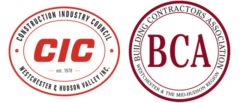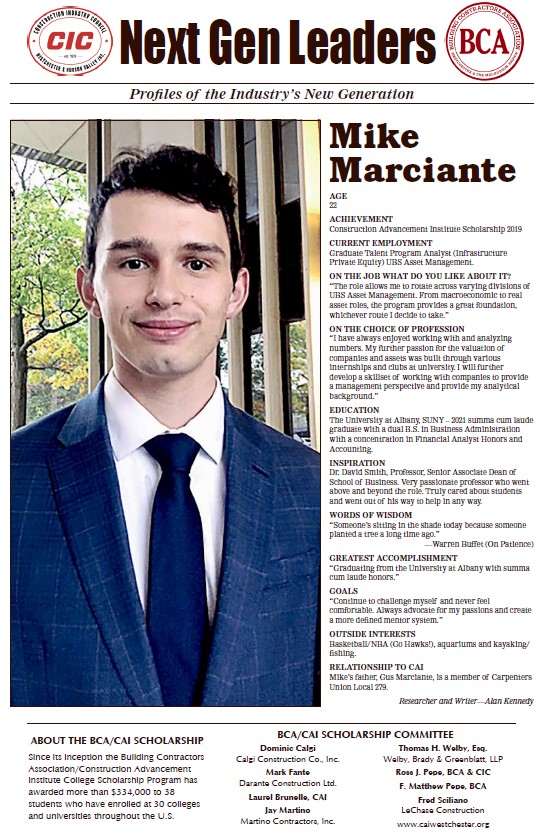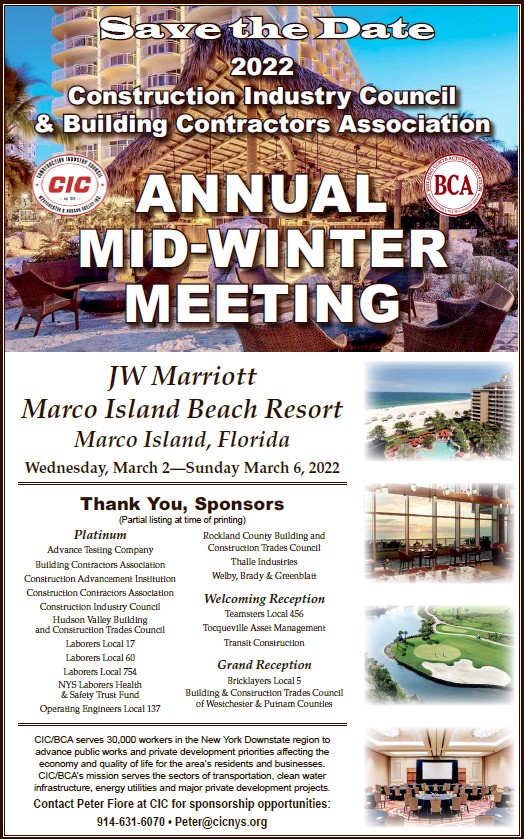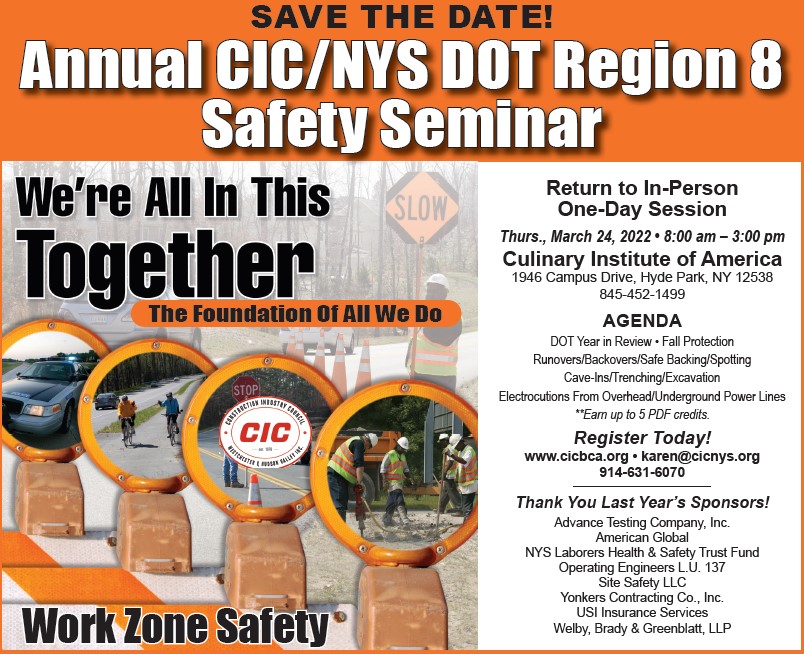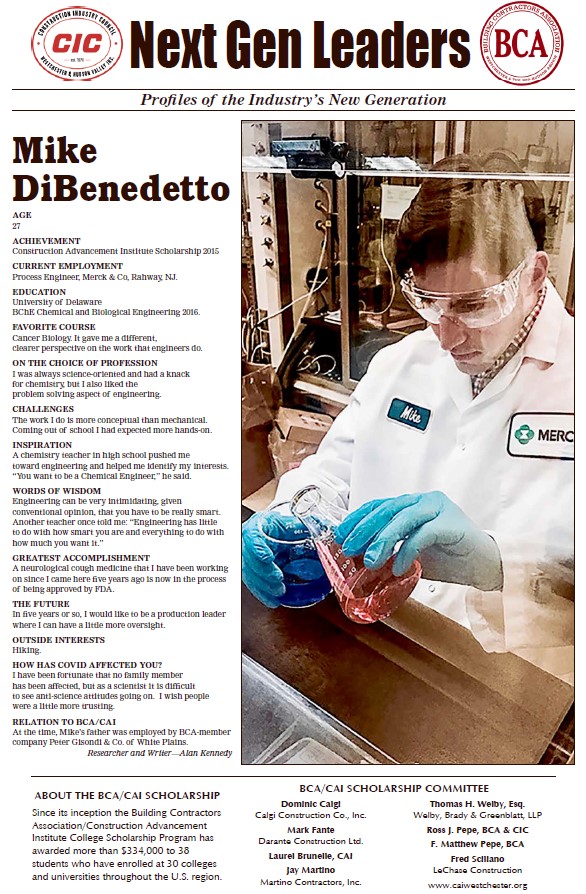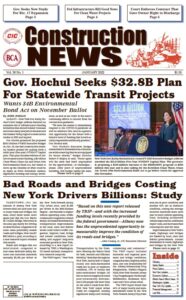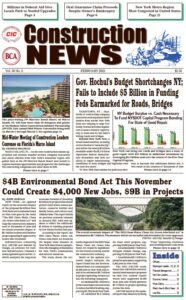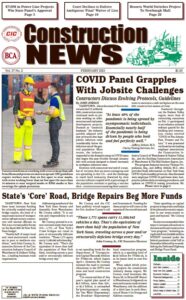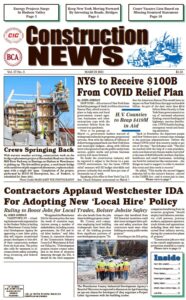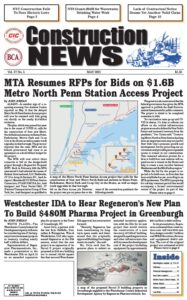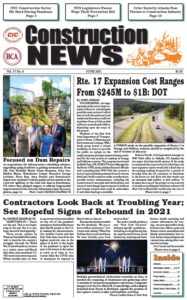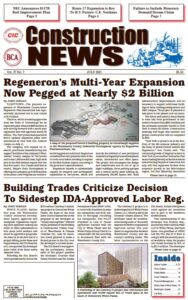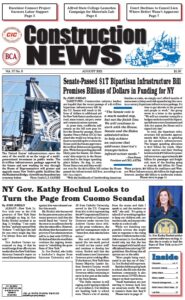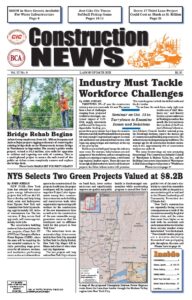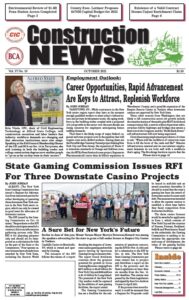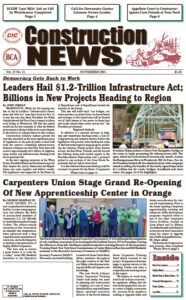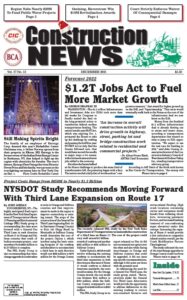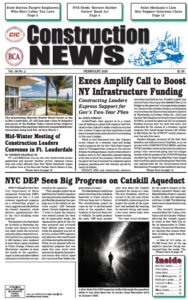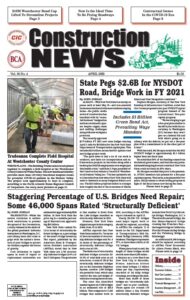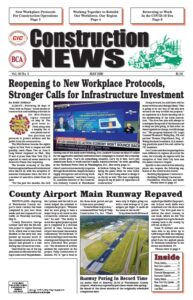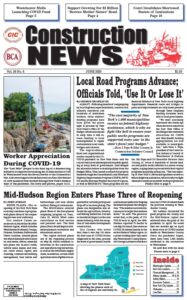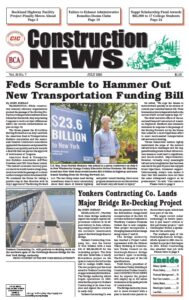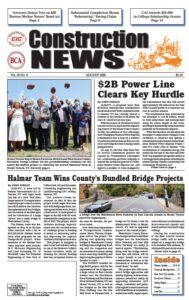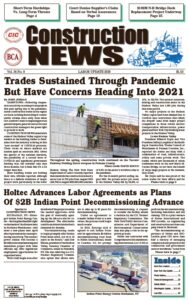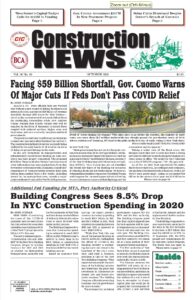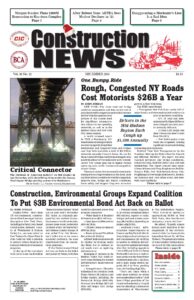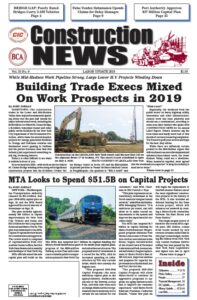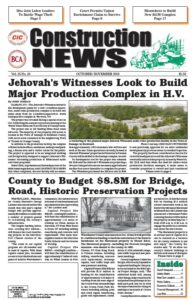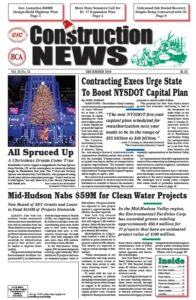News
Gov. Hochul’s Budget Shortchanges NY; Fails to Include $5 Billion in Funding Feds Earmarked for Roads, Bridges
TARRYTOWN, NY — Hundreds of contracting company executives and organized-labor leaders from across New York State are rallying to urge Gov. Kathy Hochul and state legislators to seize a historic opportunity to fund and fix the state’s failing roads and bridges.
Rebuild New York Now, a broad-based coalition, is calling on Gov. Hochul to “seize the day” and utilize the nearly $5 billion available under the $1.2 trillion bipartisan federal Infrastructure Investment and Jobs Act (IIJA) to repair deteriorating conditions of state bridges and highways over the next five years.
“If New York State makes the judicious decision to harness this additional federal aid, it will result in the creation of thousands of jobs in the

construction sector and hundreds of millions of dollars in new tax revenues and resources for local and county municipalities,” said John Cooney, Jr., executive director of the Construction Industry Council of Westchester & Hudson Valley, Inc. (CIC).
CIC is spearheading the campaign, which is scheduled to kick off on Monday, Feb. 28, at a press conference to be held at the Teamsters & Chauffeurs Local 456 in Elmsford, N.Y. The move follows a comprehensive analysis by CIC of the New York State Department of Transportation’s (NYSDOT) proposed five-year Capital Plan, which was included in the governor’s proposed FY 2022-23 budget. Rebuild New York Now determined the governor’s plan falls far short to adequately pay for state needs in general and particularly those in the Mid-Hudson Region where highways, bridges and local roads are the lifeblood of mobility for people, goods and services.
Mr. Cooney said the state’s share of the IIJA totals $13.4 billion, which is a 52% increase, or $4.675 billion, in federal aid to NYSDOT. CIC noted that on paper, this is a historic increase of approximately $1 billion a year in federal funding for New York roads and bridges. In addition, the state received in early 2021 a total of $420 million that was directly paid to NYSDOT as part of one of the federal COVID-relief programs.
However, the proposed five-year NYSDOT Capital Plan proposes annual spending levels of $6.5 billion between 2023-2027—taking into account inflation—which actually represents a significant decrease from the $12 billion budgeted between 2020 and 2022.
Testifying before the New York State Assembly Feb. 3 at a virtual Budget Forum, Mr. Cooney said, “New York State is clearly not taking advantage of a generational increase in federal funding, but rather is choosing to pocket the increased funding—at the same time the state is projected to have more than a $6-billion surplus next fiscal year beginning April 1, 2022 with surpluses in the following four years averaging $4 billion per year.”
Leaders of the Rebuild New York Now coalition said their goal is make the governor and state Legislature acknowledge the increased $5 billion in federal transportation funding, and then match it dollar-for-dollar. “With the federal match, the governor’s proposal can be increased by $10 billion over the coming five years,” Mr. Cooney said. “That’s a lot of jobs to improve safety, reduce congestion, fix bad pavement and make our bridges and overpasses structurally safer.”
Among the findings Rebuild New York Now reported to Albany lawmakers:
- NYSDOT Bridge and Highway Conditions Report showed state roads and bridges rated in “poor” or “fair” condition increased from 36% in 2016 to 45% in 2020.
- The report revealed the seven counties of the mid- and lower Hudson Valley (NYSDOT Region 8) posted the worst pavement and bridge conditions in the state.
- A review of the proposed five-year NYSDOT Capital Program shows a decrease in state and local road spending, and flat funding for CHIPS and PAVE New York programs.
“When you combine all the programs, it shows no increase in core and local funding,” Mr. Cooney informed lawmakers. “These programs affect 85% of the roads your constituents drive on. This makes no sense, especially when we are receiving $5 billion in additional federal aid.”
“The federal government has provided New York State a once-in-a-lifetime opportunity to leverage its dollars and truly make improvements in our infrastructure,” Mr. Cooney added. “We are advocating as the CIC and NYRIC—a group of construction associations across New York State—a $42.8-billion, five-year Capital Plan.”
The Rebuild New York Now coalition reported key data points that reflect the urgent need for additional investment in the state’s roads and bridges. These include:
- New York State’s pavement has steadily deteriorated over the past 22 years, to the point that 45% of statewide pavement is now rated “fair + poor,” up from 30% in 2000.
- The Hudson Valley region has experienced the second-worst drop in pavement conditions statewide (behind Western New York) from 56.9% in 2017 to 41% rated in 2020 as “Good & Excellent,” a 15% decline in just three years.
- The average annual extra cost of car repair and lost productivity in the Hudson Valley is $1,839. In the downstate New York City region, it’s $3,192, according to the TRIP report released in January 2022.
- In a poll in January 2022, 66% of respondents said New York State spends “too little” on transportation infrastructure. More than 73% of respondents “favor increasing” state funding for road and bridges.
About Rebuild New York Now: Rebuild New York Now is a broad-based coalition comprised of members of the construction industry, organized labor and business enterprises, representing more than 30,000 workers and their families with the common goal of investing in infrastructure to ensure the safety and economic health of New York State. The campaign is being spearheaded by the Construction Industry Council of Westchester & Hudson Valley, Inc., the leading voice for transportation construction and environmental infrastructure, as well as utilities and commercial development in the Mid-Hudson region of New York State. The CIC is aligned with the Building Contractors Association of Westchester & The Mid-Hudson Region, Inc., and more than 30 labor unions of the Building & Construction Trades Councils in a nine-county region. For information, visit cicbca.org.
$4B Environmental Bond Act This November Could Create 84,000 New Jobs, $9B in Projects
By JOHN JORDAN – February 24, 2022
NEW YORK – An updated report on the economic impact of the proposed $4-billion New York State environmental bond act that now goes by the name “The 2022 Clean Water, Clean Air, Green Jobs Bond Act” will reap the construction industry tens of thousands of jobs and an overall economic impact of $8.7 billion in direct and indirect project spending if approved by voters this November.
Infrastructure consulting firm AECOM and Rebuild by Design, an advocate for resilient infrastructure,

released a newly updated report on Feb. 11. which analyzed the long-term economic benefits of investing $4 billion in projects that would protect clean water, reduce pollution, conserve habitat and family farms, and reduce local climate risks. The report builds on previous research released in January 2021, with new updates to reflect the additional $1 billion in funding proposed by Gov. Kathy Hochul this year.
According to the report, the 2022 Clean Water, Clean Air, Green Jobs Bond Act would be the largest bond measure in New York State history and provide life-changing investments for New York’s communities and natural resources.
The study shows the economic impacts of the 2022 Clean Water, Clean Air, Green Jobs Bond Act would be significant for the overall economy and for the construction industry.
Based on the updated economic impact analysis, the report found that the Environmental Bond Act could support 84,000 jobs in New York and result in an estimated $8.7 billion in project spending, broken out into the following categories:
- An estimated $4.1 billion to protect and repair natural areas to reduce harmful flooding, supporting 38,700 jobs in New York.
- An estimated $1.9 billion for clean water projects, supporting 20,800 jobs in New York.
- An estimated $1.7 billion to mitigate climate change, supporting 18,100 jobs in New York.
- An estimated $1.1 billion to preserve open space, supporting 6,300 jobs in New York.
The 2020 AECOM study found that a $3-billion environmental bond measure proposed by then Gov. Andrew Cuomo would have supported 65,000 local jobs and would generate $6.7 billion in project spending across the state.
AECOM stated in the updated report that, based on its study, “From improving resilience and avoiding future costs from severe storms to creating social and public health benefits for New York residents, applicable research has found that projects associated with the four key categories of spending are shown to be fiscally smart and effective investments.” The four key categories of investment from the Bond Act would be: water quality improvement, climate change mitigation, open space land conservation and flood risk reduction.
The report further found: “The Environmental Bond Act gives New York an opportunity to address the current economic crisis and mitigate the future challenges posed by climate change, while providing a boost to the state’s economy, creating jobs, protecting the state’s drinking water and other essential natural resources and improving the lives of New York residents.”
The report also noted that the bond act’s enabling legislation requires that the state makes every effort to ensure that 35% of the Bond Act’s funds be targeted to benefit “environmental justice communities.” It is also assumed that the $4-billion Bond Act would be a major boost to MWBE firms in New York State.
“We analyzed the economic impacts of the updated proposal and our findings remain clear—the Bond Act would be a useful stimulus, with the potential to support thousands of jobs in numerous sectors while spurring long-term economic growth and protecting New York’s environment for future generations,” said Anne deBoer, Manager of Sustainable Economics at AECOM. “Voters have an opportunity this year to make investments in protecting the environment that will simultaneously benefit the economy.”
“Communities in New York State are already suffering from climate change. Recent disasters from Hurricane Ida to last summer’s severe heat waves, as well as the COVID-19 pandemic, have revealed the stark reality that these events disproportionately hurt the most vulnerable populations,” said Amy Chester, managing director of Rebuild by Design. “We need to pass the Bond Act and give communities the resources they need to build infrastructure that will address climate change and put New York on a path to recovery.”
Recently, the New Yorkers for Clean Water and Jobs coalition expressed its strong support for Gov. Hochul’s proposed $4-billion Environmental Bond Act.
“The proposed bond act is a win-win-win opportunity for all New Yorkers,” said John T. Cooney, Jr., executive director of the Construction Industry Council of Westchester & Hudson Valley, Inc. “Gov. Kathy Hochul’s call to action to create a $4-billion green bond act to fund environmental infrastructure projects is unparalleled in the history of New York State. This referendum will further protect our communities from pollution and the ravages of climate change. The bond act will help protect our treasured waterways to ensure they serve as vital economic and recreational assets for both clean water and drinking water. Finally, this bond act will create meaningful employment for New Yorkers in tens of thousands of family-supporting jobs to stimulate and revitalize our state economy for everyone’s long-term benefit.”
If enacted by voters this November, the Clean Water, Clean Air, and Green Jobs Bond Act would safeguard clean drinking water, reduce air pollution, modernize infrastructure, improve parks, and reduce climate risks. In the face of rising seas, extreme heat, and frequent flooding, these historic investments are critical to New York’s health, safety, and prosperity, the New Yorkers for Clean Water and Jobs coalition , which consists of environmental, business and construction trade organizations, stated.
Orange Re-Issues RFP for Sale of Camp LaGuardia
By JOHN JORDAN – February 24, 2022
GOSHEN — If at first you don’t succeed, try, try again. Will the third time be the charm?
After a Request for Proposals in 2020 to sell the more than 258-acre Camp LaGuardia property located in the villages of Chester and Blooming Grove failed to find a viable buyer, Orange County officials said the property is once again on the market for sale, this time in the form of an RFP. This marks at least the third attempt by the county since it acquired Camp LaGuardia 15 years ago from New York City to find a buyer/developer for the property that sits adjacent to Route 17 in Southern Orange County.
The county announced on Feb. 14 that it is seeking proposals from developers on the former Camp LaGuardia complex that at one time served as a men’s homeless shelter for New York City. The county has set a deadline of April 15, 2022 for receipt of any property purchase proposals. According to the RFP that was issued on Feb. 14, a site visit is planned for Mon., March
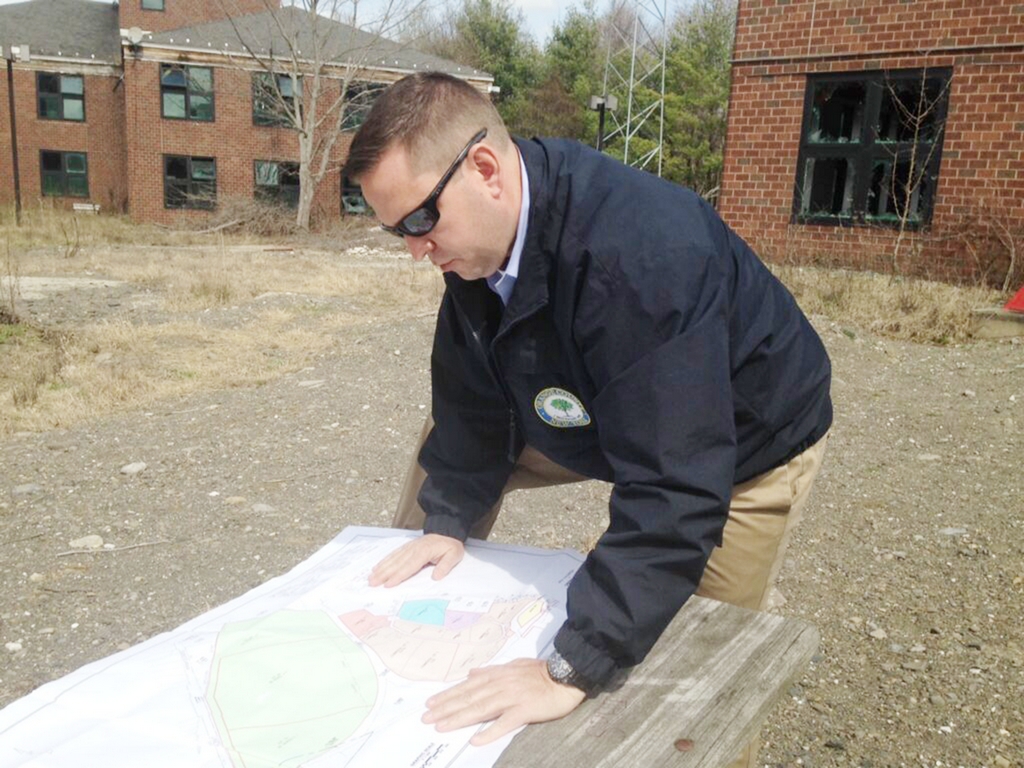
28, 2022 at 11 a.m. with a snow/rain date of March 31, 2022 at 11 a.m. According to the RFP, an interested party could seek to acquire the entire Camp LaGuardia property or a certain parcel or parcels.
“As the economy continues to recover and commercial interest in Orange County remains strong, we encourage potential investors to make offers which comply with local zoning and will create job opportunities,” said Orange County Executive Steven M. Neuhaus.
The 258-plus acre Camp LaGuardia campus is adjacent to the Heritage Trail and is close to the Route 17 corridor. There is ample space for a variety of uses in addition to commercial development, county officials stated. In the previous RFP, the county and the villages of Chester and Blooming Grove were not receptive to new residential development on the property. Among the approved zoning designations for the property include commercial, industrial and agricultural uses.
“I’m pleased that the county is moving forward to put these properties back on the tax rolls,” said Katie Bonelli, Chairwoman of the Orange County Legislature. “We anticipate proposals which will generate long term revenue for the county and are compatible with local land use requirements.”
The County Legislature will ultimately select the developers who will buy some or all of Camp LaGuardia.
Back in 2020, the county marketed the property and extended the original RFP deadline from Aug. 7. to Sept. 10, and then again to Oct. 8. The marketing campaign to sell Camp LaGuardia included an ad in the Wall Street Journal with an “Escape from New York” theme. The Orange County Industrial Development Agency provided the county with $25,000 for marketing and advertising the Camp LaGuardia site. However, those efforts eventually failed to find a viable proposal.
Orange County Executive Neuhaus is confident that the Request for Proposals process will result in the county finding a suitable buyer for the Camp LaGuardia property.
In an interview with CONSTRUCTION NEWS, Mr. Neuhaus said that over the years the county has had approximately 10 interested parties that toured the property and each came up with different concepts on how to develop the site.
“The fairest and best way to do it is to put it out to an RFP so that everybody knows exactly what the deadline is to submit their best plan,” he said.
County Executive Neuhaus noted that for the past several years the COVID pandemic had a negative impact on the economy as well as property values. In fact, he revealed that plans for a water park resort at Camp LaGuardia floundered as the pandemic dragged on. While stressing that there will not be any residential development on the property, proposals in the past have included warehouse, theme parks, etc.
He said the county felt that with property values now booming, this is the time to once again solicit proposals for the property and approve a plan that will meet with the approval of both Blooming Grove and Chester.
“We will see some good proposals come out of this and we will see who is real and who is not,” Mr. Neuhaus said.
He said that he personally would like to retain a portion of the property, specifically land by the Orange County Heritage Trail for public use.
The County Legislature voted to acquire Camp LaGuardia, a homeless shelter for New York City residents, in 2007. The county attempted to have the Camp LaGuardia property redeveloped and retained Mountco Construction of Scarsdale, NY as the developer, but in 2016 spent approximately $1.3 million to terminate the deal with Mountco, which had proposed a $300-million mixed-use development on the property but failed to secure approvals from affected municipalities to allow the project to break ground.
The Camp LaGuardia property features four parcels totaling 258.3 acres including a 153.5-acre parcel in the Town of Chester; a 40.8-acre parcel in the Town of Chester; a 59.6-acre parcel in the Town of Blooming Grove and a 4.4-acre parcel in the Village of Chester.
Information on the current RFP can be found at: https://www.orangecountygov.com/1968/2022-RFP-Sale-of-former-Camp-LaGuardia-P.
Billions in Federal Aid Give Locals Pathway to Upgrade Infrastructure
ALBANY—Local governments across New York State spent $2 billion on road maintenance, repairs and upgrades in local fiscal year (FY) 2020, a decline of 7% since 2010 when adjusted for inflation, according to a report released on Jan. 28 by New York State Comptroller Thomas P. DiNapoli.
Some local communities put road projects on hold during the pandemic, but an influx of federal money is expected to jump start projects at the same time Gov. Kathy Hochul is proposing more funding for road repair and improvements.
Local governments own 85% of all roads in the state—from local streets to major county highways. The remaining 15% are mostly state and federal highways. The study focuses on areas outside New York City. Mr. DiNapoli urged state and local officials to work together to prioritize projects and do a comprehensive assessment of local road conditions since the last study was from 2013.

“Local roads are the lifeblood of our communities, but when they are in poor condition, under construction, or being repaired they can limit our access to schools, businesses, and loved ones,” said Mr. DiNapoli. “The state is expected to receive $13.5 billion over five years for highway and bridge programs through the federal Infrastructure Investment and Jobs Act. I’m pleased the Executive is taking advantage of this unprecedented influx of aid, which should allow us to make significant progress in prioritizing local road projects and modernizing the infrastructure in our communities.”
Spending Trends
Local spending, excluding New York City, for all road-related purposes increased by 11% between FY 2010 and FY 2020, an annual rate of 1%, lower than the average inflation rate of 1.7% over the same period. Adjusted for inflation, spending declined 7% over the ten-year period.
Road-related spending declined by 7% between FY 2019 and FY 2020, with spending down for all classes of government except villages. Health restrictions and budget effects due to the COVID-19 pandemic may have been a factor, as local governments reduced spending or limited operations. This followed an unusually large increase of 8% in FY 2019, over half of which took place in five municipalities: Erie and Nassau counties, the City of Port Jervis and the towns of Hempstead and Oyster Bay.
Regional Spending
Local governments outside of New York City spent $2 billion in FY 2020 for road and highway maintenance and capital improvements, with towns leading the way at $771 million, followed closely by counties ($707 million). Villages spent the most per lane-mile of road at $22,100. More densely populated suburban, downstate counties had the highest total road spending by all local governments when measured by per lane-mile, while more rural upstate counties had the lowest. Westchester County had the highest overall in FY 2020 at $25,944, followed by Rockland County and Nassau County, with each spending more than $24,000 per lane-mile. Lewis County in the North Country spent the least at $3,169.
Local government spending on roads also varied by region when considering measures of the tax capacity of local government and population. Downstate, where property values are generally higher, spending compared to full property value is lower, while upstate is higher. On Long Island, local road spending was $0.75 per $1,000 of the full value of property in 2020, while the Southern Tier ranked highest at $3.85 per $1,000. Per capita spending was the lowest on Long Island at $151 and highest in the Southern Tier at $257.
State and Federal Aid
Local governments receive transportation aid from the state and federal government for roads and certain other transportation infrastructure, and both can fluctuate. State aid is provided through several programs, most notably the Consolidated Local Street and Highway Improvement Program. In State Fiscal Year (SFY) 2021-22, CHIPS funding for local governments, including New York City, was increased from the annual amount of $438 million, a level previously unchanged since 2013, to $538 million.
Of the $13.5 billion expected from the federal Infrastructure Investment and Jobs Act for formula-funded state and local highway and bridge programs (including New York City), $4.1 billion represents new funding, including $1.7 billion for existing highway programs and $551 million for new highway programs. An additional $1.9 billion is anticipated for bridges.
The SFY 2022-23 Executive Budget proposes a $32.8 billion, five-year Transportation Capital Plan, which includes a new multiyear initiative designed to improve state, New York City and other localities’ road conditions, as well as continued funding for CHIPS and the Marchiselli program, extreme winter recovery, the PAVE NY program, and the BRIDGE NY program.
Assessing Need
The most recent comprehensive assessment of New York’s local funding needs for roads is a 2013 study from the New York State Association of Town Superintendents of Highways, which found that locally owned roads would need around $32 billion over 15 years. The state Department of Transportation maintains current data on state and federal highway conditions, as well as a relatively small subset of locally owned roads, but there is no comprehensive data on local road conditions. This information is critical to determine the level of local spending needed to maintain roads in safe and adequate condition.
Mr. DiNapoli said efforts by the state, working with local governments, to improve the availability and quality of data on local road conditions, maintenance needs, and associated costs, could improve the prioritization of projects and help ensure the best use of these critical resources. This would be especially beneficial with the state and its local governments set to receive several billions of dollars in additional resources for road and bridge maintenance and improvements in the years ahead.
Obituary
Ernest Pacchiana
Construction, Real Estate Executive
STORMVILLE, NY – Ernest Leonard Pacchiana, a member of a leading construction family in the region, who enjoyed a long career in both public works and private construction and real estate development, died peacefully at his home here on Jan. 18, 2022 with his family present. He was 84 years old.
Following military service, he began his career working in the family construction business, Thalle Construction, where he managed many municipal and university projects. In time he would embark on his own real estate and residential development career as a certified professional engineer.
“Ernie,” as he was known to friends and family, was born in Mount Vernon, NY on April 8, 1937 to parents Anselmo and Marie Pacchiana. He attended Iona Prep School in New Rochelle, NY, where his football exploits helped the team win the first-ever NYSCHSAA championship.
He then attended Union College in Schenectady, NY where he earned a bachelor’s degree in civil engineering.

Ernie joined the U.S. Army and served during the Cold War of the late 1950s as an engineer.
He was a longtime Little League and CYO basketball coach and organizer. In his own family he saw a need for kids who still wanted to play baseball after Little League, so he then created the Pony League middle distance baseball for his youngest son and friends. He also introduced paddle tennis to northern Westchester, and the sport’s courts located in Briarcliff, NY in Westchester were dedicated in his honor.
He was a founding member of the Briarcliff Rotary Club chapter with other local businessmen, and always in the spirit of creating new organizations in his community when he saw the need.
Ernie is survived by his loving wife, Nannette Stone, his five children, Dean, Adam, Jennifer, Jean Marie and Joseph, whom the family said in a statement, “he loved slightly more than his dogs (too numerous to name),” and also his longtime first wife and devoted mother of his children, Kathryn Adams.
While there are no immediate plans for a funeral service due to changing pandemic conditions, a celebration-of-life gathering is planned for Father’s Day weekend. Family members may be contacted for details.
Donations in his memory are requested to be directed to the Briarcliff Rotary Club or the Westchester SPCA.
Attorney's Column
Oral Guarantee Claim Proceeds Despite Owner’s Bankruptcy
By THOMAS H. WELBY, P.E., ESQ. and GREGORY J. SPAUN, ESQ.
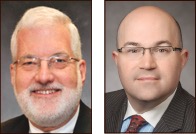
It is not unusual that an owner or an upstream contractor encounters financial difficulties during a project that jeopardizes—or completely stops—the contractor’s payments. However, in today’s modern world, the owner may be but a cog in a larger wheel, with ramifications suffered by others who are somehow related to, or set to benefit from, the construction (such as lenders, parent entities, and others). In such instances, in order to salvage the benefits of the construction, those related to the owner may agree to pay the contractor to finish its work in place of the owner or even pay the contractor for the previous unpaid work.
In the recent case of Villnave Construction Services, Inc. v Crossgates Mall General Company Newco, LLC, an appellate court reminds us that such agreements must generally be in writing, and that the exceptions to that general rule are narrow.
Background
In 2016, defendant Albany MIB+K, LLC leased a space at the Crossgates Mall with the intention to operate a franchise of Waxy’s Modern Irish Bar and Kitchen. In March of 2017, defendant Waxy O’Connor’s Management Company, the franchisor and representative of the Waxy’s brand, worked with MIB+K to negotiate a construction agreement with defendant Trinity Building and Construction Management Corp. for the construction and to ensure that the buildout would be consistent with other Waxy’s locations.
After construction commenced, MIB+K began to fall behind on payments. In order to have the construction continue, Waxy O’Connor’s Management Co., and defendants Ashok Patel, Amisha II, LLC, and Jasmine Hotel Management (the group of which were all somehow related to Waxy O’Connor’s), and defendant Crossgates Mall Devco, LLC (the Mall), promised to pay Trinity if Trinity would continue the construction. Shortly thereafter, when MIB+K filed a bankruptcy petition, Trinity’s principal reached out to the Waxy’s Group and the Mall to ascertain their intentions. The Waxy’s Group and the Mall responded by orally committing to pay Trinity for its continued performance, so long as Trinity would not suspend its work under the contract (as was its contractual right) based on MIB+K’s failure to pay. Based on these oral promises, Trinity continued to perform under the contract. However, Trinity only received a partial payment from one of the Waxy’s Group.
Ultimately, when MIB+K’s lease was terminated based on the non-payment of rent, one of Trinity’s unpaid subcontractors filed, and sued to foreclose, a mechanic’s lien. Trinity cross-claimed against the Waxy’s Group and the Mall to recover on the oral promises of payment, specifically asserting claims for unjust enrichment, promissory estoppel, and breach of the guarantee. The Waxy’s Group and Mall defendants moved to dismiss, arguing that the unjust enrichment claim failed in light of the express written contract between Trinity and MIB+K, and that the alleged guarantee promises were not enforceable as they were not in writing.
Decision
First, as to the unjust enrichment claim (and as this column has repeatedly noted), under controlling case law, such claims generally fail in the presence of an enforceable written contract covering the subject of the unjust enrichment claim. However, because of MIB+K’s bankruptcy filing, the enforceability of that contract was called into legal question (since the bankruptcy court has the authority to discharge the contract). Accordingly, the court held that the unjust enrichment claim could be asserted as an alternate to what may be an unenforceable discharged contract.
Turning to the oral promises, the court also correctly noted (as similarly noted in this column in the October 2020 edition of CONSTRUCTION NEWS) that generally, such promises have to be in writing in order to be enforceable. However, here, unlike in the case referenced in the previous column, Trinity alleged that it entered into an agreement to not only perform under the old contract with MIB+K, but it also agreed to refrain from terminating its contract with MIB+K—even though it had the legal right to do so. This delay in terminating its performance under the contract benefitted the Waxy’s Group and Mall defendants by permitting them time to avoid their own personal obligations under the defaulted MIB+K lease. Given these allegations of new consideration—separate and apart from those obligations that Trinity was already under—and the new benefits to be realized by the promisors, the narrow exception to the Statute of Frauds (a law requiring certain agreements to be in writing) could apply, and the claim was permitted to proceed to discovery on this issue.
Comment
It is always comforting for a contractor, when faced with financial difficulties of an owner or an upstream contractor, to find solace in another’s promise to pay. However, such oral promises are generally unenforceable unless they fit into a narrow exception. Accordingly, the gold standard of course is to get such promises in writing. Failing that, you should consult with experienced construction counsel so that you can take actions, similar to those referenced by the court here, which will permit you to allege, and ultimately show, that the promise to pay is supported by new, additional consideration (such as not exercising a right you would otherwise have exercised under the contract), and the new promise benefits the promisors directly in some way. Essentially, you are making a new contract, so be prepared to treat (and document) it as such. As we so often caution: If it isn’t in writing, it didn’t happen!
About the author: Thomas H. Welby, an attorney and licensed professional engineer, is General Counsel to the Construction Industry Council of Westchester and the Hudson Valley, and is the Founder of, and Senior Counsel to the law firm of Welby, Brady & Greenblatt, LLP, with offices located throughout the Tri-State/Greater Metropolitan Region. Gregory J. Spaun, General Counsel to the Queens and Bronx Building Association, and an attorney and a partner with the firm, co-authors this series with Mr. Welby.
Financial Management
New Wage Theft Law Brings Greater Risks for GCs
Know Your Subs, Beware of Liabilities, Avoid New Penalties
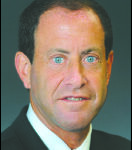
The beginning of 2022 marked an important change in the construction tax, compliance and regulatory landscape. On Jan. 4, New York’s amendments to the Wage Theft Protection Act went into effect, applying to contracts executed, modified, extended or renewed from the date enacted and after. Specifically, the law establishes greater liability risk for general contractors, construction managers and top-tier subcontractors that engage their own contractors and vendors, as well as institutes more stringent wage-reporting requirements for all subcontractors.
Liability Flows Up – Liability will now be the full responsibility of general contractors (or top-tier construction or managers; whichever reports directly to the owner/developer). If there are any discrepancies, errors or omissions of wages to employees, the liability flows all the way up the chain of payment. Regardless of the source of the wage theft claim, whether it be a third party, a union, attorneys or an individual employee, the top-line contractor on the project is responsible and liable for damages, lost and back wages, benefits, penalties incurred and any other payment issues that may arise as a result of nonpayment claims. Included in the liability for general contractors are health, welfare and retirement benefits, as well as vacation, separation and holiday pay, if left unpaid or payment can’t be established. Basically, top-line contractors need to ensure every employee on a project is paid agreed-upon rates and benefits.
In effect, the legislation included in the Davis-Bacon Act of 1931, which places the onus on top-line contractors to ensure payment to all workers on federally funded or public projects, has now been expanded to encompass private projects as well. With these sweeping changes taking place, general contractors will need expertise on New York Labor Law requirements to ensure they are overseeing and maintaining payroll, wages and benefits for all employees on a construction site.
Here’s what you need to know.
Penalties for Noncompliance – There can be significant penalties for noncompliance, whether intentional or not. The penalties can include 100% of unpaid wages plus prejudgment interest of 16% and attorneys’ fees. In addition, contractors may face Department of Labor penalties. All of this can equal approximately 200% of the unpaid wages. Depending on the extent of the transgression, this has the potential to be a substantial expense that eats into profit margins for general contractors.
But this isn’t an uncontrollable risk. Here’s how you can be proactive to avoid issues down the line.
Develop a Thorough Qualification Process – General contractors and those in similar positions should prepare thoroughly and be vigilant across the project lifecycle. Review all contracts (especially agreed wages and benefits), updates to language or change orders thoroughly. Clarify your subcontractors’ audit rights and plan for potential alterations or change orders that may be needed down the line, especially now, when supply chain delays are the norm.
Similarly, detailed record-keeping needs to be instituted among all subcontractors. Increased oversight and scrutiny of wages by the state means that general contractors can be held responsible for subcontractors that keep incomplete records. For instance, a subcontractor that does pay its employees but pays in cash and doesn’t keep payment receipts for each transaction can be the subject of a wage theft claim by a disgruntled worker. If that subcontractor doesn’t or can’t resolve the claim, that liability flows upward and stops at the general contractor. Regular reviews of subcontractor payroll reports are imperative to address issues early. Track the subcontractor’s employees and hours worked at your jobsite and compare these to the actual hours as well as comparing their rates. Ensure you have the personnel to do this diligently and project executives should make sure this is happening regularly.
Know Your Subcontractor – Due diligence also starts with the hiring process. With labor shortages and a steeply increasing demand for work following a stark slowdown, general contractors on demanding projects may find themselves hiring subcontractors that they may not have considered before March 2020. For those subcontractors, the project demands may stretch their capabilities, resources and workforces in ways they’re not accustomed to. This can result in cashflow problems and, consequently, payroll issues.
Exacerbating this, labor and material costs are rising–as are supply delays–and bids aren’t keeping up with the costs, according to research. This puts strain on every stakeholder in every project. General contractors need to engage in thorough due diligence on every subcontractor or vendor they engage. These subs will need to demonstrate the appropriate capabilities and manpower as well as cash reserves and strong track records of fiscal responsibility. Past payroll issues or insolvency in particular are a red flag.
Make Sure What’s Good For the Industry Is Good for You – There are industry benefits to the WTPA. Contractors and subcontractors that are compliant and operate transparently will be able to level the playing field in the bidding process. This will also allow for greater MWBE participation in projects. The law will ostensibly reduce the number of bad actors in the market.
The other side of this is that general contractors are largely responsible for carrying out industry change. It’s crucial that construction firms and project managers have the resources and expertise to carry out proper due diligence across all of their projects in New York state.
Consider utilizing experts to help guide planning and the execution of wage strategy that protects you and ensures a compliant, transparent construction project.
About the author: Phillip Ross, CPA, CGMA is an Accounting and Audit Partner and Chair of the Construction Industry Group at Anchin, Block & Anchin, LLP. For more construction industry thought leadership and content, log on to www.anchin.com.
A dubious Distinction
NY Metro Region Most Congested in U.S.
By JOHN JORDAN – February 24, 2022
ARLINGTON, VA– The American Transportation Research Institute released its annual list highlighting the most congested bottlenecks for trucks in America and roads in the New York metropolitan region ranked highest on the list.
For the fourth year in a row, the intersection of I-95 and SR 4 in Fort Lee, NJ is once again the Number One truck bottleneck in the country, according to the report released on Feb. 9. The average speed in Fort Lee adjacent to the George Washington Bridge is 30 miles per hour with a peak average speed of 22.4 miles per hour.
Others on the Top 10 list include: Cincinnati: I-71 at I-75; Houston: I-45 at I-69/US 59; Atlanta: I-285 at I-85 (North); Atlanta: I-20 at I-285 (West); Chicago: I-290 at I-90/I-94; Los Angeles: SR 60 at SR 57; Dallas: I-45 at I-30; San Bernardino, CA: I-10 at I-15 and Chattanooga, TN: I-75 at I-24.
A number of major roadways in the New York City metro region made the top 100 truck bottleneck list. They are:
- At #17 is the I-95/I-287 junction in Rye, NY in Westchester County, having an average speed of 46.6 miles per hour and a peak average speed of 44.5 miles per hour.
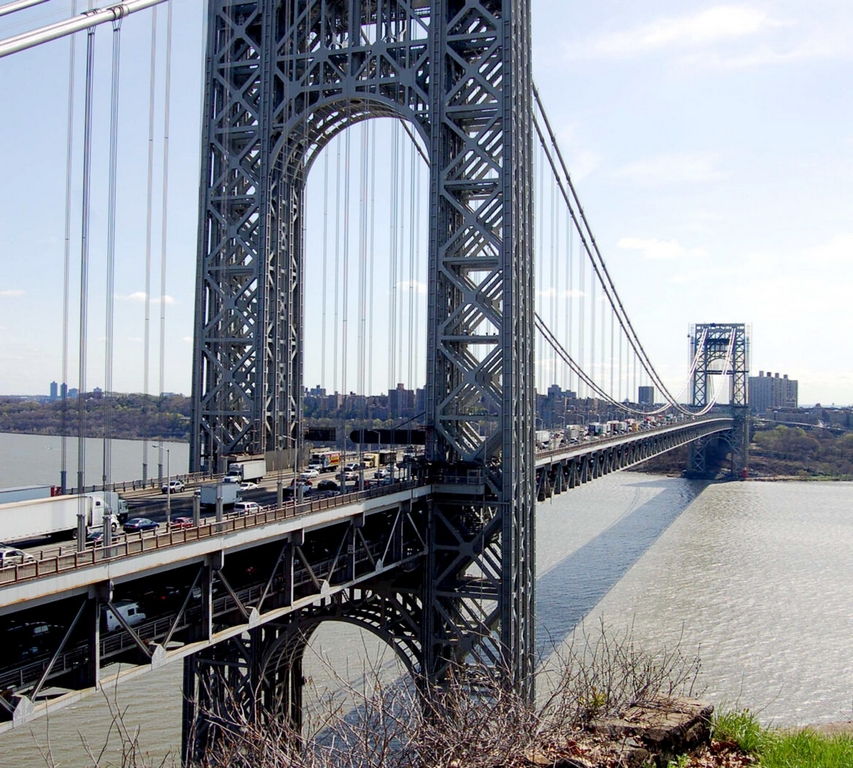
- At #20 is I-278 (Brooklyn-Queens Expressway) at the Belt Parkway in Brooklyn, which has an average speed of 34.9 miles per hour and a peak average speed of 29.5 miles per hour.
- A section of I-495 (Long Island Expressway) in Queens came in at #31 with an average speed of 24.9 miles per hour and a peak average speed of 17.2 miles per hour.
- A section of I-678 in the Bronx came in at #39 with an average speed of 32.2 miles per hour and a peak average speed of 28.1 miles per hour.
- A portion of the Long Island Expressway at Shelter Rock Road in Manhasset was #73 on the truck bottleneck list with an average speed of 44.2 miles per hour and a peak average speed of 36.3 miles per hour.
- A section of I-287 in Nyack near the Mario M. Cuomo Bridge came in at #74 with an average speed of 48.7 miles per hour and a peak average speed of 41.8 miles per hour.
- In Connecticut, a section of 1-95 in Stamford came in at #37 with an average speed of 43.9 miles per hour and a peak average speed of 34.5 miles per hour.
The 2022 Top Truck Bottleneck List measures the level of truck-involved congestion at over 300 locations on the national highway system. The analysis, based on truck GPS data from more than 1 million freight trucks uses several customized software applications and analysis methods, along with terabytes of data from trucking operations to produce a congestion impact ranking for each location. ATRI’s truck GPS data is also used to support the U.S. DOT’s Freight Mobility Initiative. The bottleneck locations detailed in this latest ATRI list represent the top 100 congested locations, although ATRI continuously monitors more than 300 freight-critical locations.
“ATRI’s bottleneck list is a roadmap for federal and state administrators responsible for prioritizing infrastructure investments throughout the country. Every year, ATRI’s list highlights the dire needs for modernizing and improving our roads and bridges,” said American Trucking Associations President and CEO Chris Spear. “We have seen, most recently in Pittsburgh, that the cost of doing nothing could also cost lives. It’s time to fund these projects and get our supply chains moving again.”
ATRI’s analysis, which utilized data from 2021, found traffic levels rebounded across the country as more Americans returned to work and consumer demand for goods and services continued to grow. Consequently, supply chain bottlenecks occurred throughout the country. Average rush hour truck speeds were 38.6 miles per hour, down more than 11% from the previous year.
ATRI is the trucking industry’s 501©3 not-for-profit research organization. It is engaged in critical research relating to freight transportation’s essential role in maintaining a safe, secure and efficient transportation system.
State Approves $879M in Bonds for NYC; $41 Million for Local Drinking Water Jobs
ALBANY—New York Gov. Kathy Hochul announced on Feb. 15 that the Environmental Facilities Corporation Board of Directors approved $41 million in funding that includes low-cost loans and previously awarded grants, enabling the recipients to access these loan and grant funds and move their water and sewer infrastructure projects forward.
The board also approved an $879-million leveraged bond financing to provide capital for various wastewater and drinking water projects for the New York City Municipal Water Finance Authority (NYCMWFA) and to refund certain prior bonds. Refunding bond sales deliver additional savings for EFC’s municipal partners by refinancing the original bonds that funded their projects at an even lower interest rate. The transaction is estimated to save $18 million for New York City ratepayers over the next 10 years.
The board’s approval includes financing through the Clean Water State Revolving Fund (“CWSRF”) and Drinking Water State Revolving Fund (“DWSRF”) and grants pursuant to the Water Infrastructure Improvement
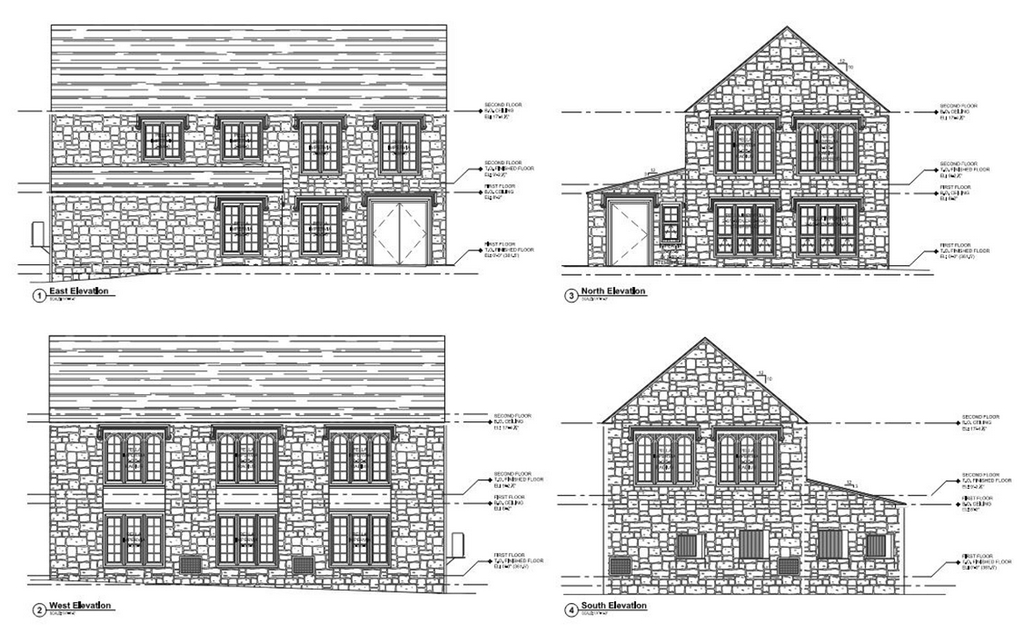
Act (WIIA). Municipal participation in the Environmental Protection Agency (EPA) Clean Watersheds Needs Survey (CWNS) starting in March is critical as it impacts how much federal CWSRF funding will be allocated to New York State to fund future clean water infrastructure projects. Municipalities will be asked to submit to EFC documentation of their community’s wastewater infrastructure needs for submittal to EPA.
Both Gov. Hochul and Environmental Facilities Corporation President and CEO Maureen A. Coleman said the action maximizes the resources and stretches dollars for water infrastructure investments. Refunding bonds helps make New York’s State Revolving Funds some of the most efficient and effective in the nation, it was noted, because the deal will free up capital to support additional infrastructure projects while providing interest rate relief to the state’s biggest borrowers.
Local Clean Water Project Funding Approved:
New York City Municipal Water Finance Authority—$284,783,326 in long-term leveraged financing to design and construct various combined sewer overflow, wastewater collection system, and treatment plant improvement projects.
Suffolk County—$4,644,642 WIIA grant and $3,400,000 in short-term, market-rate financing to plan, design and manage construction of the Suffolk County Coastal Resiliency Initiative sewer parcels currently using onsite systems in the Carlls River and Forge River watersheds.
Local Drinking Water Project Funding Approved:
Town of Cairo in Greene County—$1,607,457 in long-term, interest-free financing to develop additional groundwater source capacity; improve the Park Well site and existing finished water storage tank, distribution system upgrades and installation of new water meters and meter reading equipment.
Town of Crawford in Orange County—$2,311,680 WIIA grant, $711,329 in short-term, interest-free financing and $1,422,658 in short-term, market-rate financing for the construction of two production wells and a water treatment building, and installation of approximately 6,100 linear feet of water main to connect the treatment facility to the distribution system.
New York City Municipal Water Finance Authority—$150,000,000 in long-term leveraged financing for the design and construction of the Croton Water Filtration Plant and associated facilities.
Village of Nyack in Rockland County—$3,000,000 WIIA grant to replace approximately 13,000 linear feet of water main.
Oyster Bay Water District in Nassau County—$286,000 Intermunicipal Grant (IMG) for an emergency interconnection between the Oyster Bay Water District and Locust Valley Water District.
Westchester Joint Water Works in Westchester County—$3,200,000 IMG for the construction of a new ultraviolet light disinfection facility at the Rye Lake Pump Station.
Gov. Hochul’s FY 2023 Executive Budget proposes significant funding for clean water initiatives, including:
- $500 million in clean water infrastructure funding, bringing the state’s total clean water investment to $4.5 billion since 2017
- $400 million—a record level of funding for the Environmental Protection Fund (EPF)—to support critical projects that work to mitigate the effects of climate change, improve agricultural resources, protect water sources, advance conservation efforts and provide recreational opportunities.
- $4 billion for the landmark Clean Water, Clean Air, and Green Jobs Environmental Bond Act. If approved by voters this fall, this historic initiative will provide the support New York State needs to restore critical environmental habitats; reduce flood risks; conserve additional lands and open spaces; protect and improve our water resources; and invest in climate change mitigation projects that will reduce pollution and lower carbon emissions.
Economic Outlook
New York Office Market Gains Ground in Q4
By MICHAEL PATON

During the fourth quarter of 2021, according to JLL research, the U.S. office market registered positive net absorption for the first time since the beginning of the COVID-19 pandemic. Despite the Delta and Omicron COVID-19 variants disrupting daily life and return-to-office policies still uncertain, leasing velocity increased by 9.2% in Q3-Q4, lifting full-year leasing volume 14.6% above 2020 levels. At the same time sublease space stabilized and vacancy rates plateaued.
The broader macroeconomic recovery improved, with more than 6.1 million new jobs created over the course of 2021 along with record consumer spending and major legislation passed to boost infrastructure investment. Given widespread vaccine availability, the
development of new therapeutic treatments and leisure travel trending toward pre-COVID levels, optimism is growing for a stronger economic performance in 2022.
Sun Belt markets such as Atlanta, Austin, Charlotte, Dallas, Miami, Nashville, Phoenix and Raleigh led leasing activity, with many of these markets approaching pre-pandemic levels of leasing volume. However, larger gateway cities such as San Francisco continued to lag somewhat. Across sectors, leases larger than 100,000 square feet grew significantly faster than the market as a whole, rising by 46.6% over the quarter and representing 43.6% of activity. Additionally, another increase in deals longer than 10 years is underlining growing momentum from major tenants, leading term lengths to rise for a fourth consecutive quarter to 7.8 years on average.
According to Cushman and Wakefield, the New York office market ended the year seeing a marked improvement in leasing fundamentals over 2020. Q4 leasing velocity reached record-high levels since the pandemic following strong momentum in Q3. The disconnect between corporate occupiers’ return to office timelines and leasing activity persisted with the Delta and Omicron variants, as many companies committed to new leases despite pushing back office re-entry. Approximately 5.7 million square feet of leases transacted in Q4, totaling 17.8 million square feet in 2021, which represented an increase of nearly 20% from 2020. According to Newmark research, the flight to quality has grown over the course of the pandemic, with leases signed in trophy product growing as a percentage of overall velocity from 7.7% in 2020 to 13.1% in 2021.
Class A product (top of the line) in Midtown led market recovery in Q4, as notable transactions closed at year-end including MSG Entertainment’s 428,000-square foot lease at PENN 2, Chubb Insurance’s 240,000-square-foot lease at 550 Madison Ave, and Touro College’s 243,000-square-foot lease at 3 Times Square. Many tenants opted for longer-term leases upon gaining greater clarity for space needs, raising the average term length to about nine years, which is in line with pre-pandemic levels. By the same token, some occupiers continued to withdraw their listed spaces from the market, which lowered overall vacancy for the first time since Q1 2019 to 14.6% in Q4 2021.
The Midtown market in particular, recorded a significant uptick in tenant demand as new leasing reached an eight-quarter high of 4.9 million square feet, driven by five new leases each greater than 100,000 square feet. At 12.1 million square feet, 2021 new leasing outpaced the 2020 volume by about 36% with 31 leases greater than 50,000 square feet signed during the year—up from 21 transactions in 2020. All the Midtown submarkets, with the exception of Penn Station, recorded a year-to-year uptick in leasing. Financial services dominated market activity during the year, accounting for 40% of new lease transactions of 10,000 square feet and greater. The improvement in leasing was offset by 10 blocks greater than 100,000 square feet entering the market, resulting in vacancy climbing by 100 basis points during the quarter to about 20%. The addition of 996,000 square feet of the former Ernst and Young space entering the market at Five Times Square fueled the uptick in vacancy.
The commercial office market outlook is still clouded. According to Cushman and Wakefield, the market in New York City is still challenged with about 68 million square feet of vacant space, more than two-thirds of which is product built before 1970. Buildings with attractive amenities and transit accessibility will be best positioned to meet shifting workplace preferences, along with better air quality and more green space. The recovery therefore will continue to be uneven, with the top- end of the market and new supply expected to see the greatest demand.
The competition for talent will shape leasing trends as employees seek greater flexibility, and the office workplace will play a key role in retaining and attracting top talent. Newly implemented hybrid work arrangements and occupancy strategies will become more unique and tailored to meet specific business needs and employee demands.
About the author: Michael J. Paton is a portfolio manager at Tocqueville Asset Management L.P. He joined Tocqueville in 2004. He manages balanced portfolios and is a member of the fixed-income team. He can be reached at (212) 698-0800 or by email at MPaton@tocqueville.com.
Construction NEWS
PHOTO GALLERY
Road & Bridge Relief Needed
The worst bridges in the Hudson Valley region—those rated in poor/structurally deficient condition—carry more than 2.6 million vehicles each day. Orange, Dutchess and Ulster counties are home to some two dozen of the region’s worst bridges with the highest average daily traffic.
Photo Credits: DAVID ROCCO
Pictured above starting top left moving clockwise:
Pine Hill Road/US I-87 overpass that is located in Highland Mills, NY Orange County, it is in poor condition, in need of extensive repairs.
Southbound on Route 52 in Fishkill/Eastbound I-84
Meadow Hill Road over I-87/New York State Thruway in the Town of Newburgh.
Route 32 over the New York State Thruway in the Town of Rosendale in Ulster County.
Cross County Parkway viaduct over the Bronx River Parkway eastbound in Westchester County.
Taconic Parkway Southbound and I-84 Eastbound in Dutchess County.
Workforce Development
Laborers Local No. 17 Secures $200K Grant for Job Training
WASHINGTON—Rep. Sean Patrick Maloney announced on Feb. 7 that a $200,000 grant from the Bipartisan Infrastructure Law to fund training for 122 students and create at least 33 environmental jobs in the Hudson Valley had been awarded to Laborers Local No. 17 of Newburgh, NY.
The grant is going to the Laborers’ Local 17 Training and Education Fund, based in Newburgh, which will target disadvantaged communities and provide opportunities for job training that will directly address local environmental issues. As a member of the Transportation & Infrastructure Committee, Rep. Maloney helped write the Bipartisan Infrastructure Investment and Jobs Act, which provided the funding for this grant and other critical investments in the Hudson Valley.
The grants for Laborers’ 17 and other organizations are funded by the EPA’s Brownfields Program, which received more than $1.5 billion from the Infrastructure Investment & Jobs Act.

“I am proud to announce that Laborers’ Local 17 will receive a grant from the EPA for $200,000 for their job training program thanks to the Bipartisan Infrastructure Law. These funds will be used to create jobs, train unemployed and low-income students, and address local pollution,” said Rep. Maloney. “The Infrastructure Law is putting Americans to work to rebuild our country in a sustainable way, starting right here in the Hudson Valley.”
“This grant allows our members to continue to build their skills and opportunities, and impact their own communities through their work,” said L. Todd Diorio, Business Manager of Laborers’ Local 17. “The infrastructure act continues to impact our members in the Hudson Valley.”
The Laborers’ Local 17 Training & Educational Fund plans to train 122 students in New York’s Capital District and the Mohawk and Hudson Valley regions and place at least 33 in environmental jobs.
The training program includes 712 hours of instruction, including Federal Occupational Safety & Health Administration courses, asbestos, lead and hazardous waste trainings, and first aid and CPR classes.
Students who complete the training will earn up to three state certifications and nine federal certifications.
The Laborers’ Local 17 Training & Educational Fund is targeting unemployed, underemployed, dislocated students and those that live in poverty, distressed communities, have little or no advanced education, and minorities that live in communities affected by environmental hazards.
Key partners include the Orange County Workforce Development Board, One Stops, Eastern NY Laborers’ Local 190, Laborers’ Local 157, Professional Abatement Contractors, Rural Ulster Preservation Company, Habitat for Humanity, the Department of Social Services, various local departments of public works, Orange County Partnership, SUNY Orange Community College, BOCES, Newburgh Enlarged City School District, the City of Newburgh, United Way, the Workforce Development Institute, Best Resource Center, Working Solutions, Nubian Directions II, Inc., BRC, Workforce Development Board/Working Solutions Herkimer, Madison & Oneida Counties, Inc., LIUNA Local 190, 157, 754, and 235, the New York State Department of Environmental Protection, Construction Contractors Association, the Capital Region Workforce Development Board, Holt Construction and Specialty Trades Contracting LLC.
Metro North’s Rinaldi To Serve as Interim President of LIRR
NEW YORK—The Metropolitan Transportation Authority Chair and CEO Janno Lieber announced on Feb. 10 the appointment of Catherine Rinaldi to serve as interim president of MTA Long Island Rail Road. Ms. Rinaldi will concurrently serve as president of Metro-North Railroad, a role she has held since 2018. She will succeed Phillip Eng, who is retiring after nearly four years as LIRR president.
Ms. Rinaldi grew up in Huntington, L.I., and previously served as vice president and general counsel at the Long Island Rail Road from 2008 to 2011. In addition to her roles at both the Long Island Rail Road and Metro-North, she has served as MTA deputy executive director and general counsel, and chief of staff and counsel at MTA headquarters. Ms. Rinaldi’s first day as interim LIRR president will be Sat., Feb. 26.
“Cathy Rinaldi is a proven leader with nearly 20 years of experience at the
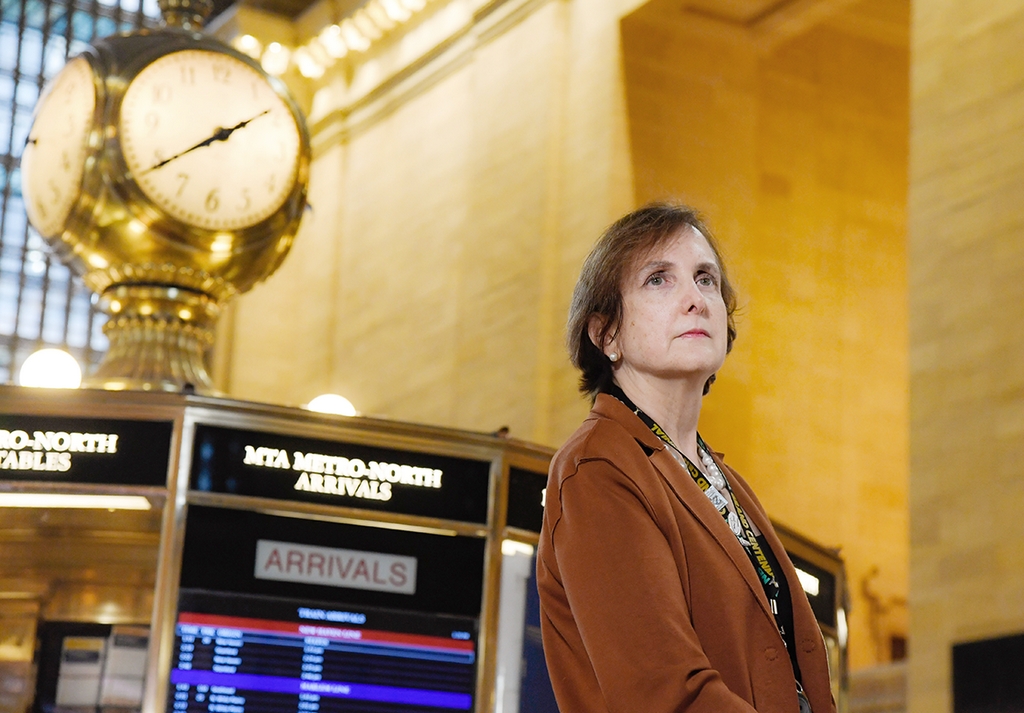
MTA, having served in leadership positions at headquarters and both commuter railroads,” Mr. Lieber said. “At Metro-North, she has led efforts to improve system reliability, achieve excellent customer service, and continue the intensive infrastructure work essential to maintaining system safety. She has great relations with labor, has the respect of her staff and puts the customer first. Phil has done an incredible job as president of the LIRR, strengthening operations through the LIRR Forward Plan and overseeing historic infrastructure investments like East Side Access and Third Track—all the while navigating a once-in-a-century crisis with COVID.”
“I want to thank Janno for the confidence that he’s putting in me by giving me this unbelievable opportunity and this unbelievable challenge,” Ms. Rinaldi said. “I’m very grateful for it. I’m very grateful to be able to serve in this way and excited for the challenges ahead.”
As LIRR interim president, Ms. Rinaldi will oversee the expansion of LIRR service. Most critically, this includes the opening of LIRR service to Grand Central Terminal later this year, the culmination of the East Side Access project. This expansion also includes running new service made possible by the recent addition of a third track between Floral Park and Hicksville on the busy Main Line, increasing capacity to run trains in both directions throughout the day. Paired together, these investments enable more frequent service to more destinations, improving travel options for both Long Islanders and commuters throughout the region.
An engineer with deep background in infrastructure and construction, Mr. Eng joined the MTA in 2017 following a distinguished career at New York State Department of Transportation where he rose to the rank of executive deputy commissioner. At MTA, he served as COO and then concurrently as acting president for New York City Transit, before being named LIRR president in 2018.
“I can retire knowing that I leave the LIRR well positioned for continued success with a dedicated management team and a tenacious workforce who are delivering the best train performance in LIRR history while fulfilling our commitments on a historic capital program,” Mr. Eng said. “I will always fondly look back on my time working with the MTA family as one of the highlights of my career. The MTA is the backbone of New York—and I will always cherish the opportunity I had working alongside our hardworking, dedicated workforce.”
Diana Rojas-Hoyos Joins CIC/BCA To Expand Administrative Services
TARRYTOWN, NY—The Construction Industry Council of Westchester & Hudson Valley, Inc. has announced that Diana Rojas-Hoyos has joined the association in the newly created position of Member and Administrative Coordinator.
In this new position, Ms. Rojas-Hoyos is responsible for maintaining and ensuring the accuracy of member information and record-keeping at the 600-member trade group.
“Diana is a timely addition to the organization as the CIC ramps up for what could be a record-setting year for construction volume thanks to the passage of the federal bipartisan infrastructure act,” said John T. Cooney, Jr., CIC’s executive director. Among her responsibilities are to maintain the integrity of CIC and BCA management information systems with all its functions and data entry challenges.
She will also provide administrative support to CIC members and partner organizations for programs and special events.
Ms. Rojas-Hoyos joins the CIC organization with more than 13 years of managerial and administrative work experience in labor union and medical environments. Her prior employers included International Brotherhood of Teamsters Local 282 Building Material in Lake Success, NY from 2016 to 2021. Prior to that, from 2008 to 2015, she worked in medical records-keeping with a medical office in the Bronx and Westchester.

She is bilingual in Spanish and English, and she earned her Medical Billing & Coding Certificate in 2012 and in 2006 was a graduate of Saunders Trades & Technical High School in Yonkers, NY. She is the mother of two young children.
CIC Appoints Maria Donovan, Esq. To Lead Events & Communications
TARRYTOWN, NY—The Construction Industry Council of Westchester & Hudson Valley, Inc. has named public affairs specialist Maria Donovan, Esq., to the newly created position of Events & Communications Manager. The announcement was made by CIC Executive Director John T. Cooney, Jr., who heads the association, which serves as the leading advocate and thought leader for the region’s construction and building industry sectors.
“As we enter 2022, I am delighted to have Maria join our team,” Mr. Cooney said. “These are exciting and challenging times for our industry as infrastructure has suddenly become the No. 1 priority on federal, state, and local levels to help drive the economy. Maria has a strong background in public affairs, having worked in both the executive and legislative branches of government at both the municipal and state level, as well as serving as an advocate for industry affairs.”
“I have been closely involved with building and construction for more than a decade and have witnessed first-hand the many benefits that improvements in public works and real estate development can bring to communities and municipalities,” Ms. Donovan said. “It is a great privilege to join CIC and its powerful alliance that unites the contracting community with organized labor and the vast networks of service providers in the building and construction sectors in the Hudson Valley.”

In her new role Ms. Donovan will spearhead CIC’s relationship development and social media communications, developing new opportunities for members to be engaged with the association. She will also support the association’s advocacy, strategic planning and public relations efforts.
Prior to joining CIC, she served as Strategic Director for the City of Mount Vernon and Deputy Chief of Staff for a State Senator in Queens, with responsibilities that included the JFK Airport Redevelopment, MTA bridge replacements, sewer rehabilitation projects along with hundreds of miles of road resurfacing. In addition, Ms. Donovan has extensive private sector experience, including roles with Empire Government Strategies and the New York Affordable Reliance Electricity Alliance.
She earned a B.A. in English from New York University in 2006, and her J.D. from Hofstra University School of Law in 2014.
Ms. Donovan is an avid runner and reader and serves on the Putnam County Home Improvement Board. In her spare time, she loves to explore the Hudson Valley with her husband Chris and rescue dog Nova.
Ms. Donovan can be reached at 914-631-6070 or at maria@cicnys.org.
Construction Material Costs Soared 20.3% in January
WASHINGTON—Prices of construction materials jumped more than 20% from January 2021 to January 2022, according to an analysis by a leading trade association of government data released in mid-February.
The producer price index for inputs to new nonresidential construction—the prices charged by goods producers and service providers such as distributors and transportation firms—increased by 2.6% from December to January and 20.3% over the past 12 months, according to the Associated General Contractors of America. In comparison, the index for new nonresidential construction—a measure of what contractors say they would charge to erect five types of nonresidential buildings—climbed by 3.8% for the month and 16.5% from a year earlier.
“Unfortunately, there has been no letup early this year in the extreme cost runup that contractors endured in 2021,” said Ken Simonson, the association’s chief economist. “They are apparently passing on more of those costs but will have a continuing challenge in getting timely deliveries and finding enough workers.”
A wide range of inputs contributed to the more than 20% jump in the cost index, Mr. Simonson noted. The price index for steel mill products soared 112.7% over 12 months despite declining 1.6% in January. The index for plastic construction products climbed 1.8% for the month and 35.0% over 12 months. The index for diesel fuel jumped 5.1% in January and 56.5% for the year. The index for aluminum mill shapes jumped 5.6% in January and 32.7% over 12 months, while the index for copper and brass mill shapes rose 4.1% in January and 24.8% over the year.
Architectural coatings such as paint had an unusually large price gain of 9.0% in January and 24.3% over 12 months. The index for lumber and plywood leaped 15.4% for the month and 21.1% year-over-year. Other inputs with double-digit increases for the past 12 months include insulation, 19.2%; trucking, 18.3% and construction machinery and equipment, 11.4%.
Association officials said construction firms are being squeezed by increases costs for materials and labor shortages. They urged federal officials to take additional steps to address supply chain disruptions and rising materials prices. These include continuing to remove costly tariffs on key construction components.
“Spiking materials prices are making it challenging for most firms to profit from any increases in demand for new construction projects,” said Stephen E. Sandherr, the association’s chief executive officer. “Left unabated, these price increases will undermine the economic case for many development projects and limit the positive impacts of the new infrastructure bill.”
Nearly 224,000 U.S. Bridges Need Repair: ARTBA
WASHINGTON— Nearly 224,000 U.S. bridges need major repair work or should be replaced, according to the American
Road & Transportation Builders Association’s (ARTBA) analysis of the recently released U.S. Department of Transportation (DOT) 2021 National Bridge Inventory (NBI) database. That figure represents 36% of all U.S. bridges.
If placed end-to-end, these bridges would stretch more than 6,100 miles, said ARTBA Chief Economist Dr. Alison Premo Black, who conducted the analysis released earlier this month. That’s the distance from New York City to Baghdad, Iraq as the crow flies.
The Infrastructure Investment and Jobs Act, signed into law last November, provides states with significant new resources to make long overdue infrastructure improvements, including bridge repairs. However, Congress and the Biden
administration have yet to release much of the additional funding because they have not enacted a full-year FY 2022 transportation appropriations law at the IIJAauthorized investment levels. The current continuing resolution, which holds spending for most federal surface transportation programs flat at FY 2021 levels, ends Feb. 18.
“The longer it takes to bridge the political divide on the FY 2022 spending bills, the longer it will take for transportation improvements to get started,” ARTBA President & CEO Dave Bauer said. “We urge Congress to act forthwith so that the American people can begin to realize the benefits of the historic investments in the bipartisan infrastructure law.”
Based on average repair and replacement cost data published by the Federal Highway Administration (FHWA) and submitted by bridge owners (typically state DOTs), ARTBA estimates the cost of identified repairs for all 224,000 bridges, including the 43,578 structurally deficient, is $260 billion.
Among other findings in the report:
- 78,800 bridges should be replaced
- The number of structurally deficient bridges was down by 1,445 compared to 2020. At the current pace, it would take 30 years to repair them all.
- Almost half of the 619,588 U.S. bridges—48%—are rated in fair condition. This means that the bridge shows evidence of minor deterioration or minor cracks. The number of bridges in fair condition grew by 2,916 in 2021, reaching 297,888 structures.
- States with the largest number of bridges in poor condition were: Iowa (4,504), Pennsylvania (3,198), Illinois (2,405), Oklahoma (2,296), Missouri (2,218), New York (1,672), Louisiana (1,631), California (1,493), West Virginia (1,490) and Ohio (1,334)
- States and territories with the most bridges in poor condition as a percentage of their total bridge inventory were: West Virginia (20%), Iowa (19%), Rhode Island (17.5%), South Dakota (17.3%), Pennsylvania (13.8%), Louisiana (12.7%), Maine (12.6%), Puerto Rico (12.1%), North Dakota (11.2%), and Michigan (11%).
LOW BIDS
Constar, Elegant Lawns, Aquifer Beaver, H&L, Oliveira Win Bids
ALBANY—The New York State Department of Transportation recently announced the selection of six apparent low bidders for work in the Hudson Valley and New York City metro regions.
Constar Inc. of Central Islip, NY was the lowest of four bidders at $1,073,054.00 for crack and joint sealing on asphalt pavements regionwide in the Bronx, Kings, New York, Queens and Richmond counties.
Elegant Lawns & Landscaping of Inwood, NY was the lower of two bids at $198,180.00 for biennial mowing, Palisades Interstate Parkway in Clarkstown, Haverstraw, Highlands, Orangetown, Ramapo, Stony Point and Woodbury in Orange and Rockland counties.
Aquifer Drilling & Testing Inc. of Mineola, NY was the sole bidder at $1,390,310. for biennial geotech subsurface explorations regionwide in Columbia, Dutchess, Orange, Putnam, Rockland, Ulster and Westchester counties.
Beaver Concrete Construction Inc. of Hazlet, NJ was the lowest of 13 bidders at $82,777,750.50 for bridge replacement and mobility improvement, Oceania Street Bridge and EB Long Island Expressway in Queens.
H&L Contracting LLC of Hauppauge, NY was the lowest of five bidders at $16,791,000. for pavement preservation, various locations in New York City in Bronx, Kings, New York, Queens and Richmond counties.
Oliveira Contracting Inc. of Albertson, NY was the lowest of six bidders at $3,287,743. for concrete pavement preservation at various locations in New York City in Bronx, Kings and New York counties.
LeChase, H.I. Stone Land Westchester DPW Jobs
WHITE PLAINS—The Westchester County Department of Public Works has reported the selection of two apparent low bidders for work at its facilities in Westchester County.
LeChase Construction Services, LLC of Armonk, NY was the lowest of 10 bidders at $8,457,966. for New Equipment Storage Building, Richard A. Flynn, Sr. Fire Training Center at the Valhalla Campus in Valhalla, NY.
H.I. Stone & Son Inc. of Southbury, CT was the lower of two bids at $11,224,980. for removal and disposal of sewage sludge from the Ossining, Peekskill and Port Chester wastewater treatment plants.
Fleetwash, Power Line Constructors Secure Thruway Authority Projects
ALBANY—The New York State Thruway Authority has reported the selection of two apparent low bidders for work in the Hudson Valley/New York City regions.
Fleetwash Inc. of Homer, NY was the lower of two bids at $497,848. for maintenance bridge washing on I-95, New England Thruway between M.P. NE 0.24 and M.P. NE 14.93 in the Bronx and Westchester counties.
Power Line Constructors Inc. of Clinton, NY was the lowest of three bidders at $1,722,241.85 for replacement of its equipment at various locations in Albany Division in Ulster, Greene, Albany, Rensselaer, Columbia, Schenectady and Montgomery counties.
Gov. Hochul Seeks $32.8B Plan For Statewide Transit Projects
By JOHN JORDAN – January 24, 2022
ALBANY — New York Gov. Kathy Hochul’s first budget address featured an extensive list of infrastructure funding initiatives that should bolster revenues and create many new jobs in the state and the Hudson Valley region’s construction trades in 2022 and beyond.
Gov. Hochul presented the proposed $216.3-billion FY2023 Executive Budget on Jan. 18, one that construction industry leaders praised for putting forth a multi-year (five-year) NYSDOT Capital plan. That plan includes billions of dollars in mass transit funding, a $4-billion Clean Water, Clean Air, and Green Jobs Environmental Bond Act, her intent to move up the timeline on what could be as many as three downstate casinos, significant housing and energy investment, as well as tax relief in the state’s continuing efforts to recover from the coronavirus pandemic.
“We have the means to immediately respond to the COVID-19 pandemic as well as embrace this once-in-a-generation opportunity for the future with a historic level of funding that is both socially responsible and fiscally prudent,” Gov. Hochul said.
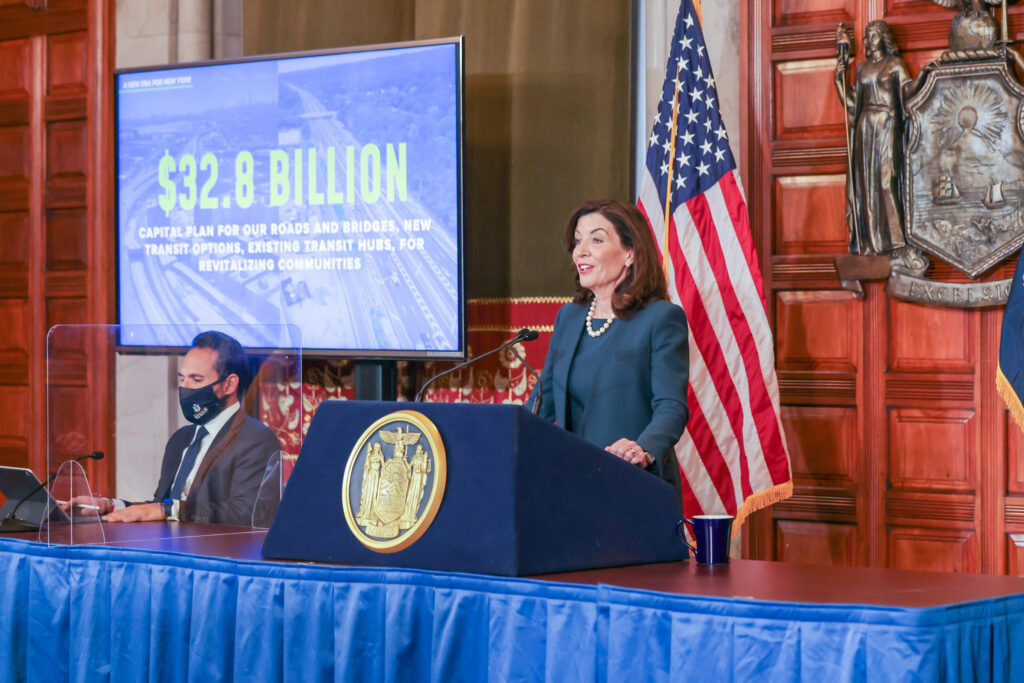
“Gov. Hochul’s Executive Budget makes historic investments in critical areas while ensuring that we are equipped for future shocks,” Budget Director Robert F. Mujica Jr. said, “Never again will the state find itself unprepared for the opportunities—or challenges—ahead. After years of unprecedented hardship, this budget makes the state, from a financial perspective, as resilient as its spirit. It is the budget that New Yorkers deserve and expect.”
Stephen Morgan, secretary of the New York Roadway & Infrastructure Coalition, said that at first blush the infrastructure funding proposals put forth by the governor would indicate a significant uptick in activity in 2022 and beyond. However, he cautioned that NYRIC is reviewing the governor’s various proposals and NYSDOT plan, noting that some will rely on federal program funding.
Mr. Morgan praised the governor, stating that her Executive Budget makes clear her commitment to investing in the state’s infrastructure now and into the future.
“The executive budget proposed by Governor Hochul today is a sign New York State is not only on its way to recovery—it’s coming back stronger than ever,” said Carlo A. Scissura, former president and CEO of the New York Building Congress. “Our transportation options will become more robust and efficient as part of a $92-billion, five-year capital plan, while the $1.6 billion set aside to upgrade healthcare facilities will embolden a vital sector hit significantly hard during the pandemic. The New York Building Congress applauds the governor’s executive budget and especially urges the advancement of the $4 billion Clean Water, Clean Air, and Green Jobs Environmental Bond Act. This is crucial to creating good-paying jobs in cutting-edge sectors that represent the future of our industry.”
New York State will receive an estimated $13.5 billion in highway and bridge formula aid over five years from the federal Infrastructure Investment and Jobs Act (an increase of $4.6 billion compared to the five-year Fixing America’s Surface Transportation (FAST) Act). The total includes a projected $1.9 billion of formula funding for bridges.
The Executive Budget provides $6.7 billion for the first year of a record $32.8-billion, five-year NYSDOT Capital Plan that will facilitate the improvement of highways, bridges, rail, aviation infrastructure, non-MTA transit, and NYSDOT facilities. Compared to the last five-year DOT Capital Plan, this is an increase of $9.4 billion, or 40%, according to the governor’s office.
The governor in her budget presentation listed a number of major projects to be funded in the NYSDOT Capital Plan including the Hunts Point Interstate Access Improvement in the Bronx and accelerating the conversion of Route 17 to I-86 in Orange and Sullivan counties. The governor has directed NYSDOT to begin the Environmental Impact Statement process on the roadway conversion that could include the construction of a third lane in each direction on sections of Route 17 in Orange and Sullivan. See story on page 3.
Other major projects the governor stated would be funded or advanced in this plan include phases of the replacement of I-81in Syracuse, modernizing the Livingston Avenue Bridge in Albany, reconnecting neighborhoods across the Kensington Expressway in Buffalo, and assessing ways to improve road capacity at the Oakdale Merge in Suffolk County.
Funding for the Consolidated Highway Improvement Program (CHIPS) and the Marchiselli program is maintained at last year’s level of $577.8 million. The budget provides $100 million for the new Pave Our Potholes program, $150 million in highway aid through the PAVE NY program and $200 million to fund the local projects from the BRIDGENY programs, an increase of $100 million from last year’s BRIDGENY program.
The $4-billion Clean Water, Clean Air, and Green Jobs Environmental Bond Act, if approved by voters in November, will support the restoration of critical environmental habitats; reduce flood risks; conserve additional lands and open spaces; protect and improve the state’s water resources; and invest in climate change mitigation projects that will reduce pollution and lower carbon emissions. The Bond Act will also support a substantial investment in the Clean Green Schools initiative that will reach every public school located in a disadvantaged community.
In terms of mass transit, the Executive Budget provides more than $7.3 billion in mass transit operating support: The MTA will receive $6.6 billion in state operating aid in FY 2023, including resources collected by the state and sent directly to the MTA without appropriation. On-budget MTA assistance will increase more than 24%, from $3.1 billion to more than $3.8 billion. Upstate transit systems are slated to receive $261 million, representing at least a 13% increase per system. Downstate systems will receive $471 million, representing a 36% increase per system.
The $52 billion 2020-24 MTA Capital Program remains the largest and most expansive plan in its history. In addition to the $25 billion secured in the FY 2020 Budget, the state will re-appropriate $3 billion which will be matched by the City of New York.
The governor’s Executive Budget presentation notes that Non-MTA transit capital will receive $160 million. Core appropriations will increase by 41%, from $85 million to $120 million, as part of an additional $175 million five-year investment in non-MTA transit service, and the state will again appropriate $20 million for bus electrification and $20 million to rehabilitate NFTA’s light rail.
In terms of casino expansion in the state, State Budget Director Mujica noted in published reports that the existing law and the governor’s proposal do not explicitly state where the casinos have to be located. However, he said that most of the interest from bidders will be New York City-focused.
“The three (casino licenses) will be probably focused in the downstate area, but there’s no restriction there,” he said. “If we get a bid back that’s dramatic, we’re not going to exclude them.”
Downstate business interests have been pushing for the state’s casino approval process to be accelerated. Existing limited gaming operators MGM Resorts at Empire City Casino in Yonkers, NY and Resorts World at Aqueduct Racetrack in Queens, NY are considered front-runners for full casino designation.
Other infrastructure-related funding in the 2023 Executive Budget include:
- $2.4 billion for healthcare capital infrastructure and improved lab capacity
- The Executive Budget includes $500 million to develop the state’s offshore wind supply chains and port infrastructure. The initiative will create 2,000 jobs.
The Executive Budget advances a new $25 billion, five-year Housing Plan to create and preserve 100,000 affordable homes, including 10,000 homes with support services for vulnerable populations, and electrify an additional 50,000 homes as part of the state’s plan to electrify one million homes and make another one million electrification-ready. Funding includes $5.7 billion in capital resources, $8.8 billion in state and federal tax credits and other federal allocations, $11 billion to support the operation of shelters and supportive housing units and to provide rental subsidies.
Bad Roads and Bridges Costing New York Drivers Billions: Study
TARRYTOWN — For the amount of money New York drivers shell out each year due to lousy roads and bridges, the state could build seven more spans just like the Gov. Mario M. Cuomo Bridge. Motorists in the state pay dearly for driving on deteriorated, congested or in some cases potentially unsafe roads and bridges. How much? $28 billion a year, according to a new research report released this month.
Roads and bridges that are deteriorated, congested or lack some desirable safety features cost motorists statewide annually $3,192 per driver in the New York-Newark-Jersey City urban area—and $1,835 per driver in the Mid-Hudson Region—attributable to higher vehicle operating costs, traffic crashes and congestion-related delays. Increased investment in transportation improvements at the local, state and federal levels could relieve traffic congestion, improve road, bridge and transit conditions, boost safety, and support long-term economic growth in New York, according to a new report released by TRIP, a Washington, DC-based national transportation research nonprofit.
The TRIP report, “New York Transportation by the Numbers: Meeting the State’s Need for Safe, Smooth and Efficient Mobility,” finds that throughout New York, nearly half of

major locally and state-maintained roads are in poor or mediocre condition, 10% of locally and state-maintained bridges (20 feet or more in length) are rated poor/structurally deficient, and 5,019 people lost their lives on the state’s roads from 2015-2019. New York’ major urban roads are congested, causing significant delays and choking commuting and commerce.” The TRIP report included statewide and regional pavement and bridge conditions, congestion data, highway safety data, and cost breakdowns for the Albany-Schenectady-Troy, Binghamton, Buffalo-Niagara Falls, New York-Newark-Jersey City, Poughkeepsie-Newburgh-Middletown, Rochester, Syracuse and Utica urban areas.
The TRIP report found that 44% of major locally and state-maintained roads in the New York-Newark-Jersey City urban area are in poor condition and another 24% are in mediocre condition, costing the average motorist hundreds more each year in extra vehicle operating costs, including accelerated vehicle depreciation, additional repair costs, and increased fuel consumption and tire wear.
Improvements to New York’s roads, highways and bridges are funded by local, state and federal governments. Annual investment in roads, highways and bridges by the New York State Department of Transportation (NYSDOT) increased by 37% from 2018 to 2021 from approximately $4.3 billion to $6 billion.
The level of NYSDOT highway investment is likely to increase further as a result of the five-year federal Infrastructure Investment and Jobs Act (IIJA), signed into law in November 2021, which will increase annual federal funding for New York roads, highways and bridges by 52% from an average of approximately $1.8 billion annually to $2.7 billion. Federal funds currently provide 38% of the revenue used by NYSDOT to fund highway and bridge improvements.
“Based on this new report released by TRIP—and with the increased funding levels recently provided by the federal government—Albany now has the unprecedented opportunity to measurably improve the condition of its roads and bridges,” said John Cooney, Jr., executive director of the Construction Industry Council (CIC) of Westchester & Hudson Valley, Inc. “The CIC is optimistic that through the leadership of Gov. Kathy Hochul and the New York State Legislature, this increase in allocation of federal money will serve to raise the performance levels of our roads and bridges over the coming five years. The CIC looks forward to working with our elected officials to elevate these conditions so that future TRIP New York State Transportation studies reflect the improved conditions the state’s motoring public deserves.”
In the New York-Newark-Jersey City urban area, seven percent of bridges are rated poor/structurally deficient, with significant deterioration to the bridge deck, supports or other major components. Statewide, 10% of New York’ bridges are rated poor/structurally deficient.
Traffic congestion in the New York-Newark-Jersey City urban area caused 92 annual hours of delay for the average motorist and costs the average driver $2,107 annually in lost time and wasted fuel. New York-Newark-Jersey City drivers waste approximately 324 million gallons of fuel each year due to traffic congestion, an average of 38 gallons per motorist. Statewide, drivers lose $15.4 billion annually as a result of lost time and wasted fuel due to traffic congestion. Due to the COVID-19 pandemic, vehicle travel in New York dropped by as much as 45% in April 2020 compared to vehicle travel during the same month the previous year, but rebounded to eight percent below October 2019 levels by October 2021.
“As Westchester County looks to reemerge from the pandemic it is critically important that New York stays laser focused on increasing investments in transportation improvements at the local, state and federal levels which will help relieve traffic congestion, improve roads, bridge and transit conditions,” said John Ravitz, executive vice president and COO of the Business Council of Westchester.
In the Poughkeepsie-Newburgh-Middletown urban area, 15% of bridges are rated poor/structurally deficient, with significant deterioration to the bridge deck, supports or other major components.
Traffic congestion in the Poughkeepsie-Newburgh-Middletown urban area caused 37 annual hours of delay for the average motorist and costs the average driver $658 annually in lost time and wasted fuel. Poughkeepsie-Newburgh-Middletown drivers waste approximately 3.9 million gallons of fuel each year due to traffic congestion, an average of 19 gallons per motorist.
The TRIP report found that 26% of major locally and state-maintained roads in New York State are in poor condition and another 19% are in mediocre condition, costing the state’s motorists an additional $7.7 billion each year in extra vehicle operating costs, including accelerated vehicle depreciation, additional repair costs, and increased fuel consumption and tire wear.
“These latest findings by TRIP shed more light on the continued need to address the countless roads and bridges causing businesses and employees time and money,” said Melvin Norris, senior director of government affairs for The Business Council of New York State, Inc. “These careful studies can be used as a roadmap to finally address and solve these problems altogether. We are hopeful that the federal infrastructure package will help in solving this ongoing problem.”
Statewide, 10% of New York’ bridges are rated poor/structurally deficient with significant deterioration to the bridge deck, supports or other major components. Fifty-four percent of the state’s bridges are rated in fair condition and the remaining 36% are in good condition.
Traffic crashes in New York claimed the lives 5,019 people between 2015 and 2019. New York’s overall traffic fatality rate of 0.75 fatalities per 100 million vehicle miles of travel in 2019 is lower than the national average of 1.11. In the New York-Newark-Jersey City urban area, on average, 600 people were killed in traffic crashes each year from 2015 to 2019. The financial impact of traffic crashes in which the lack of adequate roadway safety features, while not the primary factor, were likely a contributing factor was an average of $326 annually per each New York-Newark-Jersey City area driver.
The efficiency and condition of New York’s transportation system, particularly its highways, is critical to the health of the state’s economy. Annually, $1 trillion in goods are shipped to and from New York, relying heavily on the state’s network of roads and bridges. Increasingly, companies are looking at the quality of a region’s transportation system when deciding where to re-locate or expand. Regions with congested or poorly maintained roads may see businesses relocate to areas with a smoother, more efficient and more modern transportation system. The design, construction and maintenance of transportation infrastructure in New York supports approximately 319,000 full-time jobs across all sectors of the state economy. Approximately 3.5 million full-time jobs in New York in key industries like tourism, retail sales, agriculture and manufacturing are dependent on the quality, safety and reliability of the state’s transportation infrastructure network.
The authors of the TRIP report concluded their analysis of the state’s transportation network by saying, “New York must work to provide a 21st century network of roads, highways, bridges and transit that can accommodate the mobility demands of a modern society. The state will need to modernize its surface transportation system by improving the physical condition of its transportation network and enhancing the system’s ability to provide efficient, safe and reliable mobility for residents, visitors and businesses.”
They added, “Making needed improvements to New York’s roads, highways, bridges and transit systems would provide a significant boost to the economy by creating jobs in the short term and stimulating long-term economic growth as a result of enhanced mobility and access.”
Dave Kearby, TRIP’s executive director, said, “Additional federal funding from the IIJA will allow New York to move forward with needed improvements to its transportation network that will make the state’s roads and bridges smoother, safer and more efficient while boosting the economy and creating jobs. In addition to the federal investment, it will be critical that New York State continue to increase its level of transportation investment.”
Source: TRIP
Gov. Seeks New Study for Rte. 17 Expansion
State Environmental Review To Examine Third-Lane Option
By JOHN JORDAN – January 24, 2022
ALBANY —The prospect of major upgrades—including the construction of what business and government leaders say is a much-needed third lane on portions of Route 17 in Orange and Sullivan counties—just got a step closer.
Although not included in her State of the State speech on Jan. 5, accompanying material given to state lawmakers included a directive from New York Gov. Kathy Hochul to the New York State Department of Transportation to undertake an environmental review of the conversion of Route 17 to federal Interstate 86 (I-86). Later in the month, Gov. Hochul in her FY 2023 Executive Budget Address listed the conversion of Route 17 to I-86 as one of her top transportation priorities.

In her “State of the State Book “presentation, the governor said that as part of her multi-faceted transportation investment initiatives the state would accelerate the conversion of Route 17 into I-86 in Orange and Sullivan counties. Gov. Hochul stated, “Strategic investments in the Mid-Hudson Valley have resulted in the expansion of Woodbury Common and the construction of Legoland and the Resorts World Catskills Casino. Over the past several years, projects have been completed by NYSDOT to upgrade sections of Route 17, including reconstruction of the interchange at Exit 131, where Route 17 meets Interstate 87 and Route 32 (Woodbury Common), and reconstruction of Exits 122 and 125 (Legoland) to meet interstate standards. To facilitate future economic competitiveness and alleviate congestion within the region, the state will begin an environmental review to assess the conversion of the full Route 17 corridor in Orange and Sullivan counties to Interstate 86.”
NYSDOT released a statement in connection with the governor’s directive to accelerate the conversion of Route 17 to I-86, which stated: “As Gov. Hochul said in the State of the State Address, the state will undertake an environmental review to assess the conversion of the full Route 17 corridor in Orange and Sullivan counties to Interstate 86. This study will build on the work of the recently completed Planning and Environmental Linkage (PEL) study and look at alternatives along the 47-mile corridor between Orange and Sullivan counties, including Monticello.”
Michael Fleischer, a consultant with the 17-Forward-86 coalition, said that based on discussions with NYSDOT officials and the department’s aforementioned statement the environmental review will include the potential addition of a third lane on Route 17 in Orange and Sullivan counties that was included in a recently released PEL study by DOT. The study released in November 2021 rejected several options to improve congestion on Route 17 and determined a host of others that should move forward to the Environmental Impact Statement (EIS) phase, including the construction of a third lane on Route 17 in Orange and Sullivan counties, upgrades to interchanges on Route 17 in both counties and improvements that should be undertaken to improve connectivity to transit.
Mr. Fleischer also noted the length of time for the environmental review process could be shortened considerably since the PEL study involved a significant amount of work that would have to be performed in the environmental review. He noted that the environmental review will therefore not be starting from scratch.
The New York State Department of Transportation has stated that the EIS would address the engineering, social, economic and environmental impacts associated with potential corridor alternatives. If the preferred alternative was to construct a third travel lane, the EIS would also include any necessary mitigation actions/strategies.
Maureen Halahan, president and CEO of the Orange County Partnership and co-chair of the17-Forward-86 Coalition, said, “During a time when New York’s recovery is most critical, the governor specifically has a plan for economic development through infrastructure rebuild, shovel ready sites and regional councils that focus on regional growth strategies, including the conversion of Route 17 to Interstate 86.”
She later stated that she believes that the governor’s directive requires the EIS to include a thorough review of the third lane option for Route 17.
The 17-Forward-86 Coalition released a statement on social media in response to the governor’s State of the State Address, stating, “Our 17-Forward-86 Coalition is grateful to Gov. Hochul for making Route 17 a priority for investment and we look forward to working with her administration to make these long-needed upgrades a reality.”
The Construction Industry Council of Westchester & Hudson Valley, Inc. is a founding member of the 17-Forward-86 coalition.
The final report from the New York State Department of Transportation’s Route 17 Planning and Environmental Linkage Study group recommended the state move forward with an environmental review of a General Use Third Lane in each direction on Route 17 in Orange and Sullivan counties that could—if built as one major project—cost anywhere from $650 million to $1.27 billion. The PEL Study Group also called for a study of interchange upgrades be undertaken at exits in Orange and Sullivan counties and that improvements be made in the region to improve connectivity to existing transit.
The scope of the construction of the General Use Third Lane beginning at Exit 131 in Harriman (Orange County) to Exit 103 (Rapp Road) in Monticello in Sullivan County would determine the cost of the project.
Option 1, which involves using the basic existing footprint of the roadway and shoulders to accommodate a third lane in each direction would cost $385 million to $470 million for the Orange County stretch of roadway and another $265 million to $325 million in Sullivan County.
Under Option 2, which would involve widening the existing roadway to accommodate the third lane expansions in both directions so that most of Route 17 would conform to federal Interstate standards, the costs would escalate. For the Orange County section, the cost would run between $615 million to $750 million, while the Sullivan County component’s cost ranges from $425 million to $520 million.
The PEL Study Group did not recommend one option over the other. While listing interchanges in Orange and Sullivan counties that could be upgraded, it did not issue any specific recommendations, although it did point out those with the greatest need.
In referencing the need for a General Use Third Lane, the study group stated, “Reconstruction under the General Use Third Lane Alternative would provide the opportunity to address deficiencies in the existing roadway to correct non-standard features and storm-related flooding. High crash locations containing curves and overpasses would benefit from widening shoulders, increasing pavement friction, and increased banking (removal of non-conforming super elevation) under this concept. Increasing the capacity of Route 17 would provide a 24% reduction in congestion related crashes overall, per the Crash Modification Factors Clearinghouse.”
The study indicated the cost of the interchange upgrades in Orange County could run from $135 million to $175 million and in Sullivan County from $43 million to $144 million.
Improvements to Connectivity to Existing Transit projects are projected to cost between $1 million to $1.5 million in Sullivan County and $9 million to $10 million in Orange County.
The study group also recommended moving forward with a No Build scenario, but that was done chiefly because it is a requirement of the National Environmental Policy Review Act (NEPA) process for any proposed Route 17 project. The group also considered the construction of a High Occupancy Vehicle Lane and the addition of Light Rail and Bus Rapid Transit but did not recommend going forward on any of those options.
While study group officials have stated at previous virtual public workshops that the full project would likely not move forward all at once due to funding constraints and other factors, the report listed the total project cost involving the construction of the General Use Third Lane, interchange improvements and improvements to connectivity to existing transit projects would run from $529 million to $935 million in Orange County and $309 million to $665.5 million in Sullivan County.
While the Route 17 expansion may qualify for some federal funding, it is likely that the overall project would be done in phases and based on the report it appears work would begin on a stretch of the roadway in Orange County.
“As previously noted, NYSDOT will determine the logical termini and specific project limits of the General Use Third Lane Alternative in the future, following careful consideration of existing and projected traffic congestion, public and agency input, and available funding,” the report stated. “Based on this Route 17 PEL Study, the area of greatest need appears to be between Exits 120 (NY Route 211 – Wallkill) and 131 (Woodbury), a distance of approximately 22 miles, and the segment of the corridor that is projected to experience the highest levels of congestion in the year 2055.”
Advocates for the Route 17 expansion were heartened to learn that the project could receive funding from the $1.2-trillion infrastructure bill recently signed into law by President Biden when U.S. Rep. Sean Patrick Maloney (D-CD18) listed the Route 17 project at a press conference in Newburgh on Nov. 8 as one that could qualify for federal funding. He referenced the Infrastructure Act’s $13.5 billion that will go directly to New York State’s highways and bridges, and said that revamping Route 17 through Orange County is “a much-needed project that has been stalled for too long.”
“Route 17 can receive funding through the Infrastructure Investment and Jobs Act,” a spokesman for Rep. Maloney said. “However, the law does not directly earmark funds to specific projects. It will be up to New York State to determine how to dedicate their funds from this legislation to projects like Route 17. However, as he has throughout the legislative process drafting the Infrastructure Investment and Jobs Act, Rep. Maloney will continue to fight for funding for critical projects and priorities here in the Hudson Valley.”
The PEL process was initiated by the NYSDOT in cooperation with the Federal Highway Administration. The DOT last year began a scoping and preliminary review process as part of the $5-million PEL study, whose funding was secured through the 2018-2019 state budget.
The PEL study was a follow-up to a NYSDOT study released in May 2013 that examined the corridor between Monticello, Exit 103 (Rapp Road) and Harriman, Exit 131 (New York State Thruway) to help accommodate transportation demands brought about by economic growth in the region and to help accommodate future growth.
The 2013 final report recommended: adding a general use third lane, in each direction, from Interstate 87 in Harriman to just west of Middletown, Orange County; improve key interchanges in Orange and Sullivan counties; provide new and expanded park and ride lots at strategic locations in Orange and Sullivan counties and recommend some provisions for future transit.
Federal Infrastructure Bill Brings Good News For New York State Clean Water Projects
By STEVE OTIS – January 24, 2022
The recently enacted federal Bipartisan Infrastructure Law will provide an added boost to New York State’s successful network of programs to support clean water projects throughout the state. Already a national leader in providing state support for a variety of clean water funding streams, New York is well-positioned to build on past efforts because the federal infrastructure bill includes a strong focus on clean water funding from Washington not seen in decades.
The federal infrastructure bill includes $50 billion to fund drinking water and wastewater projects nationwide. Over 82% of the bill’s funding directed to the U.S. Environmental Protection Agency is dedicated to clean water infrastructure programs.
Credit for the strong emphasis on clean water in the infrastructure bill goes to Senate Majority Leader Chuck
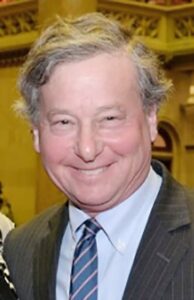
Schumer, Senator Kirsten Gillibrand and our NYS Congressional delegation who recognized the importance of these programs to New York.
The allotment for New York State for the first year will surpass $428 million. Funding categories include lead pipe replacement, drinking water programs, wastewater system support, emerging contaminants and funding for regional waterbodies such as Long Island Sound. Another priority is funding towards disadvantaged communities.
Further details will be outlined through guidance documents and regulations to be issued by the EPA next year, but most of the funding will be channeled through State Revolving Loan Funds (SRF). They are the existing state funding entity, supported by federal appropriations, that each state uses to support clean water borrowing by local governments. The SRF program was created in the late 1980s when the federal government moved away from clean water grants to a primarily low interest loan model for supporting clean water programs.
One of the outstanding elements of the new federal legislation is that as much as 49% of the new federal funding can be used towards grants.
New York State has one of the most robust and active low interest loan programs in the country. Our state program is administered by the NYS Environmental Facilities Corporation. In 2015 New York supplemented the loan program with grant programs under the Water Infrastructure Improvement Act. In the first five rounds of funding, the WIIA program, using state dollars, has awarded over $1.2 billion in grants to more than 690 projects throughout New York, creating 67,000 new jobs. Since 2017 New York has allocated $500 million a year in state funds for a variety of clean water programs with the largest share devoted to the WIIA program.
Despite this nation-leading state commitment, the demand for state assistance to support local clean water projects continues to surpass available funding. The new federal funds will assist states in meeting that demand without additional burden to state taxpayers. The fact that New York already has a number of successful state clean water programs through EFC, the Department of Environmental Conservation and the Department of Health will allow New York to immediately put the federal funds to work on clean water projects throughout our state.
The funding should provide additional gains for Westchester and the Mid-Hudson Valley. Through the efforts of local governments, regional engineering firms, labor and construction advocates like the Construction Industry Council of Westchester & Hudson Valley, our region has been very successful in securing state grants from New York’s existing programs. It is my expectation that once EPA establishes their guidelines and the state government determines how to integrate the federal funds with our state programs, clean water projects will accelerate in our region.
Another positive sign comes from Gov. Kathy Hochul. One of her first actions upon taking office was to provide a generous allocation for the 2021 clean water grant application round. I expect we will see continued strong support in 2022.
About the author: State Assemblyman Otis (91st AD) represents the Sound Shore communities of Larchmont, Mamaroneck, New Rochelle, Port Chester, Rye Brook and the City and Town of Rye. He helped initiate the Water Infrastructure Improvement Act of 2015 and has worked closely with the Construction Industry Council on promoting and expanding New York’s clean water grant programs.
Obituary
Howard Lockwood
Longtime Supplier, CIC Member
NAPLES, FL—One of the earliest members of the Construction Industry Council and owner of a leading supply company in the region, Howard Lockwood, passed away on Dec. 26, 2021 in Naples, FL at the age of 95.
Since 1978, when the CIC was formed, the trade association relied on Mr. Lockwood’s counsel and experience in a variety of matters pertaining to the construction industry. He served on several committees for the association and was highly respected by contractors, by material suppliers, including his competitors, and organized labor.
“Howard was instrumental in bringing together owners of local building material supply businesses to negotiate fair and equitable labor agreements with Westchester Teamsters,” said CIC President Ross J. Pepe.
Born in Brooklyn and growing up in Yonkers, NY, Mr. Lockwood worked from a young age in the family-owned business, Lockwood Lumber, which was founded in Yonkers by his father and his father’s siblings.
He enlisted in the Navy in 1944 at age 17 and served as a Staff Sergeant, commissioned on a sub chaser in the South Pacific.
Following his return from World War II, Mr. Lockwood met and married Eva Maria (ne Bass). They settled in Ardsley, NY, where they raised three children, Peter, Suzanne and Michael. He was involved in many aspects of his children’s lives, serving as coach, scoutmaster and other roles as he was needed. The family said he attended all the piano recitals of his daughter, Suzanne, and he never missed a hockey game during the college career of his son, Mike.

In 1976 Mr. Lockwood along with his son, Peter, departed Lockwood Lumber, venturing out on their own and purchased King Lumber, which is located in Goldens Bridge, NY—bringing that struggling business back to life. King Lumber is still a thriving enterprise today, currently run by his son Peter and his two sons, Martin and Warren.
“Howard was a very social and generous man,” his family said in a statement. “He enjoyed life to the fullest. He had very a strong work ethic and didn’t care for wastefulness. He loved his country. He cherished his friends. He enjoyed playing cards, dining and occasionally dancing.”
The statement continued, “Howard had a real passion for playing golf. He didn’t pick the game up earnestly until later in his life, but derived much joy from the competition among his buddies. He has passed that love of the game on to his family.”
Devoted to his children and his six grandchildren, he took great pride in always being there for them when they needed him. He is survived by Peter Lockwood (Mara), Suzanne (Lockwood) Pack, Michael Lockwood (Anne), and six grandchildren, Christopher, Martin, Kyle, Warren, Cara Anne and Keely. His wife of 54 years, Eva, predeceased him in 2007.
Attorney's Column
Court Enforces Whistleblower Protection in Contract That Gave Owner Right to Direct Discharge CM’s Worker
By THOMAS H. WELBY, P.E., ESQ. and GREGORY J. SPAUN, ESQ.

While this column often deals with issues relating to the construction industry, it is sometimes overlooked that construction contractors are, more generally, employers, just like those in other industries. However, those generally applicable rules can just as easily run afoul as those which are uniquely applicable to the construction industry. In the recent case of Shevlin v Wonder Works Construction & Development Corp., a court reminds us that New York’s generally applicable whistleblower protection statute (Labor Law §740) is also applicable to construction contractors.
Background
Prior to 2013, Wonder Works Construction Corp. entered into a contract with 421 Kent Development, LLC for Wonder Works to be the construction manager for a construction project at 421 Kent Ave. in Brooklyn. The contract between Wonder Works and 421 Kent provided that “[421 Kent] reserves the right to direct the removal of any of [Wonder Works’] staff for cause (at [421 Kent’s] sole discretion), including Key Personnel, and [Wonder Works] shall promptly replace such individuals with competent substitutes acceptable to [421 Kent].”
In 2013, Scott Shevlin was hired by Wonder Works to be a site superintendent at the 421 Kent Ave. project. At the commencement of the project, the 421 Kent Ave. site was surrounded by a fence around three sides, which had been left by the previous owner. The site was divided by a private street, which was guarded by rolling gates that were supposed to have been closed when not in use. The New York City Department of Buildings required that Wonder Works both build an interior fence on the fourth side of the site and keep the rolling gates closed when not in use in order to safeguard the site as a condition of lifting a previous stop-work order. If the gates were left open, the public would use the private street as a shortcut between two local thoroughfares.
A problem arose with the site’s neighbor, who preferred to leave the rolling gates open for his own convenience. As DOB continued to warn Wonder Works about leaving the gates open, Mr. Shevlin would close them. Both Wonder Works’ vice president and 421 Kent Development’s site representative would tell Mr. Shevlin he should leave the gates well enough alone, and that they did not care about whether the gates were open or closed. This indifference was communicated to Mr. Shevlin several more times prior to his termination, and Mr. Shevlin, pursuant to both DOB’s and his immediate supervisor’s instructions, would insist on keeping the gates closed.
In January 2014, Wonder Works received a letter from 421 Kent Development’s site representative directing Wonder Works to replace Mr. Shevlin with “alternative competent personnel for cause,” claiming that “Shevlin has demonstrated a lack of fiduciary responsibility and a retaliatory approach in dealing with daily issues.” In response, Wonder Works terminated Mr. Shevlin’s employment. In subsequent correspondence between Mr. Shevlin and another Wonder Works principal, Mr. Shevlin was advised that the termination was the owner’s decision, and that Mr. Shevlin did nothing wrong.
Mr. Shevlin commenced a lawsuit under New York’s Whistleblower Protection Statute, Section 740 of the Labor Law, against both Wonder Works and 421 Kent Development, alleging that he was terminated for insisting on keeping the gates closed, even though it caused consternation with the neighbor. Wonder Works and 421 Kent Development both claimed that the termination had nothing to do with the rolling gates issue. Wonder Works also claimed that in light of its contract with 421 Kent Development, it was required to terminate Mr. Shevlin and had no discretion in the matter; 421 Kent Development also claimed that it could not be held liable because it was not Mr. Shevlin’s employer.
Decision
A non-jury trial was held on Mr. Shevlin’s claim, and the court credited the testimony that there were no complaints about Mr. Shevlin’s employment other than his insistence on keeping the gates closed, and discredited the testimony that his firing was unrelated to the access issue. In order to find a violation of the version of Section 740 in effect at the time, the court also had to find that there was, in fact a violation of a statute, code, etc. The court found such a violation of Section 3307.3.4 of the Building Code, which requires that openings in fences, sidewalk sheds, barriers, and railings be closed at all times except during actual loading and unloading operations, and the court linked Mr. Shevlin’s termination to his insistence on keeping these gates closed. (The current version of the statute only requires that the employee have a reasonable belief about the violation of a statute, code, etc., not that the violation actually exists.)
The court found that Wonder Works’ defense of just following the contract was unconvincing, holding that while the contract did give 421 Kent Development the right to remove Wonder Works’ employees “for cause,” as determined to exist in the sole determination of 421 Kent Development, it could not require Wonder Works to violate applicable law in doing so. As to 421 Kent Development, even though it was the root cause of Mr. Mr. Shevlin’s termination, it was not liable because the statute was specifically made applicable to employers, and 421 Kent Development was not Mr. Shevlin’s employer. Based on these findings, the court dismissed the case against 421 Kent Development, and it directed Wonder Works to pay Mr. Shevlin $227,000 in back pay, plus his attorney’s fees.
Comment
In dealing with contractual provisions between parties, this column has routinely cautioned that obligations should be made consistent both upstream and downstream (e.g., if a GC’s contract with the owner requires arbitration, the GC should require arbitration of its subcontractors). As the Mr. Shevlin court reminds us, those obligations must also be consistent with state law, including generally applicable employment law. As Wonder Works learned here, the defense of “just following the contract” was not sufficient to save it from a significant lost wages claim—plus potentially more than $50,000 in attorney’s fees.
About the author: Thomas H. Welby, an attorney and licensed professional engineer, is General Counsel to the Construction Industry Council of Westchester and the Hudson Valley, and is the Founder of, and Senior Counsel to the law firm of Welby, Brady & Greenblatt, LLP, with offices located throughout the Tri-State/Greater Metropolitan Region. Gregory J. Spaun, General Counsel to the Queens and Bronx Building Association, and an attorney and a partner with the firm, co-authors this series with Mr. Welby.
Safety Watch
Respondent in Citation Contest Proceeding Scores Rare Win Via Summary Judgment
By GEOFFREY S. POPE, ESQ.

While summary judgment is to be employed sparingly, it is appropriate where all of the facts that will determine the outcome are admitted, or the evidence concerning them is so one-sided that it is obvious that the party moving for summary judgment must prevail as trial.
The party deeming itself entitled to summary judgment presents a motion to the court, annexing evidence (transcripts of pre-trial deposition testimony, probative documents, etc.) and a legal memorandum explaining the basis for the motion. In assessing whether genuine fact issues exist, the court must resolve all ambiguities, and draw all reasonable inferences, in favor of the nonmoving party.
In my many years of experience litigating in federal and New York State courts, I have observed that, while judges look with favor on opportunities to pare their trial dockets, they are aware that appellate rulings overturning orders granting summary judgment greatly outnumber those reversing denials of summary judgment. Where the issue is doubtful, therefore, such a motion is unlikely to succeed.
In my extensive review of decisions in citation contest proceedings, I have seldom seen summary judgment attempted by employers—no doubt in large part because preparing papers and arguing such a motion is labor-intensive on the part of the respondent’s counsel (which is to say, expensive). In the usual case, the penalty amounts at issue are often far less than in federal civil lawsuits, and the legal costs to be saved by a successful motion are often not enormous (as pre-trial discovery procedures are less extensive than in regular lawsuits, and lengthy trials are uncommon).
However, as illustrated by Secretary v. Harvestland Constructors, Inc., a garden-variety fall-protection case, it may be worth asking your attorney to ponder whether the Secretary’s case has an “Achilles’ heel,” that could make it susceptible to a summary judgment motion.
Harvestland involved a single-item citation, alleging that the employer had violated the OSH Act, by exposing employees to falling through holes in elevated working/walking surfaces by the non-use of personal fall arrest systems, covers, or guardrail systems erected around such holes.
Most of the relevant facts in this case were undisputed. An experienced, 66-year-old carpenter had a continuing assignment to identify and cover uncovered holes in the flooring on a project in Georgia. Most of these “penetrations” had been created to allow equipment to be passed from one level of the floor to another. When a hole was observed, this individual, named in the decision as “Carpenter NM,” would cover it with plywood, and he would secure the plywood sheeting with cleats, nailed in to prevent slippage.
On the afternoon of the day in question, Carpenter NM, who had been performing this work on the project for about three weeks, as he usually did was working alone on the second floor of the structure.
All Harvestland employees were required to use fall protection when working four feet or more above ground level, supervisors inspected the site several times daily for compliance, and an outside consulting firm performed monthly safety inspections. This employer had a site-specific safety plan, conducted weekly safety meetings, and sent home workers observed to be in violation of safety rules.
Carpenter NM was up-to-date in his training, had been supplied with a personal fall arrest system, and had often been observed utilizing fall protection. In five years of employment with Harvestland, he had never been cited for safety violations.
On his last afternoon, Carpenter NM covered and nailed down the cleats on nine of 13 openings existing on the second floor. About 10 to 15 minutes after returning from a break, he fell through an uncovered hole, and plunged 38 feet to his death. For reasons unknown, he was not wearing fall protection at the time.
Of the four elements constituting the Secretary’s burden in order to prove the violation, three were open-and-shut in favor of the government. Since Carpenter NM was working on a surface with openings far above the floor below, the necessity for fall protection was clear. Two additional elements—namely, a failure to comply with the fall protection standard and employee exposure—were established beyond question by the fact that Carpenter NM was not using fall protection when he fell 38 feet.
However, three elements out of four will not do, and on the fourth element—actual or constructive knowledge of the violative condition on the employer’s part—Harvestland prevailed, winning summary judgment and the vacatur of the citation.
The Secretary, as the court found, had to prove either that the employer (through a supervisor) had actual knowledge of the infraction, or that its inadequate safety program was such that a finding of constructive knowledge could be made, based on the conclusion that had the employer exercised due diligence, the violation would have come to a supervisor’s attention.
In a detailed analysis set forth in her decision, the ALJ ruled for Harvestland, because there was no triable issue that it had actual or constructive knowledge that the decedent had been working around openings in the floor without fall protection. The judge cited facts (many of them corroborated by the testimony of the Compliance Officer) concerning (among other things) the employer’s work rules, and its generally praiseworthy safety training, surveillance of its workforce and rule enforcement. Since these factors disproved constructive knowledge, and no basis existed to find actual knowledge, the citation had to be vacated.
The ALJ rejected, as immaterial, the Secretary’s contention that the arguably defective condition of a nylon strap on the harness that Carpenter M was not wearing established the violation.
Not many contests will present a strong case for summary judgment, but given the unpredictably of trials generally, and what witnesses will testify to in particular, your case should be carefully analyzed to determine if summary judgment might offer prospects of success.
About the author: Geoffrey S. Pope is of counsel to the construction law firm of Welby, Brady & Greenblatt, LLP, with its main office in White Plains. The articles in this series do not constitute legal advice, and are intended for general guidance only.
Economic Outlook
Artificial Intelligence Takes On Construction Industry Needs
By MICHAEL PATON

One of AI’s greatest strengths is its ability to explore many different variations of a model to find the best option—this is known as generative design. Generative design could be useful for designers using Building Information Modeling (BIM) technology. AI would take a BIM model and explore tens of thousands of minor and major design changes to make a design safer, more stable, or simply cheaper and faster to build. For a person to explore all these possibilities would require months—an AI engineering program could do so in hours. In addition, AI is very effective at analyzing historical data and using this to create likely forecasts of future events. An AI program could feasibly be used to train a machine to spot patterns in maintenance issues and locations. Imagine an AI system, which assesses hundreds of thousands of damage or issue reports for different kinds of buildings over time, as well as information from sensors. Eventually, it could begin to predict when certain surfaces, fittings or materials will become damaged or worn and alert maintenance teams to this.
Another use of AI is in construction project management. Construction projects frequently become delayed or experience cost overruns—even with skilled project managers overseeing them. However, AI forecasting algorithms have proven highly accurate in estimating cost overruns of projects. Project managers could use AI-enhanced software that identifies how likely their plans are to be delayed. This could help them revise projects and find ways to manage time and resources better.
AI construction robotics represents another possibility for saving time and reducing risk. We are still a long way from a world of autonomous robot bricklayers, yet firms are already providing bulldozers and excavators, which can be given defined tasks and work alone. This kind of technology could save enormous sums of money and make projects progress faster. Imagine a project in a remote location that it is difficult to get workers to—remote diggers could work 24/7 clearing sites and get the work done much faster
According to the consulting company McKinsey & Company, AI use cases in construction are still relatively nascent, though a narrow set of start-ups are gaining market traction and attention for their AI-focused approaches. There are a few early-stage examples construction firms can evaluate:
- Project schedule optimizers can consider millions of alternatives for project delivery and continuously enhance overall project planning.
- Image recognition and classification can assess video data collected on work sites to identify unsafe worker behavior and aggregate this data to inform future training and education priorities.
- Enhanced analytics platforms can collect and analyze data from sensors to understand signals and patterns to deploy real-time solutions, cut costs, prioritize preventative maintenance and prevent unplanned downtime.
The mandate for change and technological adoption of AI in construction is strengthening, and financial and strategic investors continue to fuel a rapid expansion of the construction technology industry, according to McKinsey. The COVID-19 pandemic has only added additional urgency to the preexisting productivity and data-visibility issues facing construction companies. While this next phase of growth and adoption will better equip construction industry leaders to effectively plan and manage projects, construction technology is still rapidly growing and highly dynamic. Further efficiencies will be unlocked with deeper integration of technology solutions directly on the job site and with predictive analytics leveraging data from connected teams and equipment. In the end, the “platform era” will simply create the platform upon which these emerging technologies are built.
As market barriers to AI entry in construction steadily lower—and advancements in AI, machine learning (ML) and analytics accelerate—you can expect AI (and allocation of resources funneled toward AI) to play a more significant role in construction in the future. The potential applications of machine learning and AI in construction are vast. Requests for information, open issues and change orders are standard in the industry. AI will be like a smart assistant that can scrutinize this mountain of data. It then alerts project managers about the critical things that need their attention. Several applications already use AI in this way. Its benefits range from mundane filtering of spam e-mails to advanced safety monitoring. The future, as they say, certainly ain’t what it used to be—it’s wide open.
About the author: Michael J. Paton is a portfolio manager at Tocqueville Asset Management L.P. He joined Tocqueville in 2004. He manages balanced portfolios and is a member of the fixed-income team. He can be reached at (212) 698-0800 or by email at MPaton@tocqueville.com.
LeChase Unveils Training Center to Safeguard Hospitals, Labs During Building, Reno Projects
ARMONK—LeChase Construction Services has recently opened a new private environmental training center geared at teaching construction workers the best practices for containing noise, dust and contaminants during construction projects in hospitals, pharmaceutical research companies and other critical facilities.
At a tour of its facilities last month, LeChase Construction officials showcased the training center’s mix of classroom and hands-on training, offering workers experience in containment barriers, negative air pressure, HEPA filtration, as well as good housekeeping techniques that will reduce the risk of cross contamination and provide a safe environment for patients, staff and others while nearby renovations occur.
Located at LeChase’s New York Metro office at 1 Labriola Court in Armonk, NY, the new ICRA training center—infection control risk assessment—training center will be used as a company-wide resource to ensure the firm’s employees and subcontractors stay at the forefront of the emerging and established health and safety protocols.
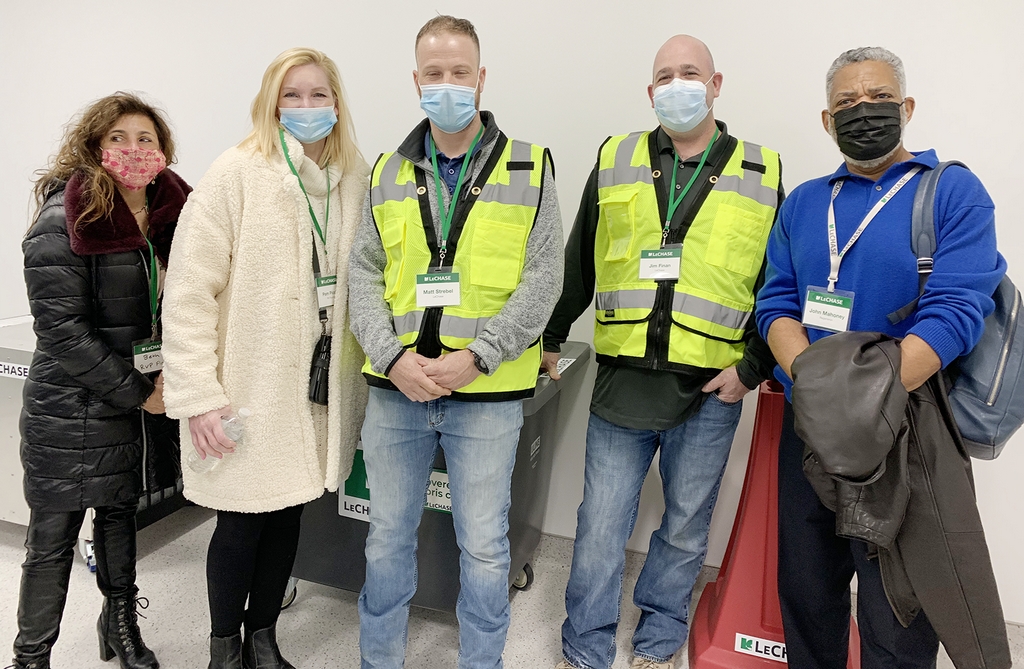
From left, Beth Boyle of Shaw Industries, a flooring manufacturer based in Georgia, Pam Piccini of RVP Flooring Systems of Carmel, Matt Strebel and Jim Finan of LeChase Construction Services in Armonk, and John Mahoney of Regeneron in Westchester.
“As LeChase continues to grow its client base in the healthcare and pharmaceutical industries, this new ICRA training center will provide a critical skill for LeChase employees and for our subcontractors” said David Campbell, LeChase vice president.
Mr. Campbell made his remarks during an event introducing the center to customers, the media and other stakeholders. “With our center, we will train workers to properly use the systems and exercise the care needed to ensure our work does not disturb hospital patients and visitors, and researchers at pharmaceutical companies,” he said.
At the 2,000-square-foot ICRA training center, workers will learn to use: temporary hard barriers to contain construction work areas; high-efficiency particulate air (HEPA) filters to remove dust and other contaminants; and techniques for personal protection and cleaning. LeChase has retained independent consultant Richard Vogel as the instructor to teach the classes at the center. Mr. Vogel was formerly in charge of infection control at New York Presbyterian Hospital prior to his retirement.
Mr. Campbell said that while the impetus to open the new environmental training center was partially due to its increased market share in the health care-biomed arena, “I think on top of that there is a real need, internally, at least for us and our clients, especially when it comes to in the last year-and-a-half with COVID, to really make sure we have tight controls on our construction space.”
Mr. Campbell said that the classes are orientation-based and are set up as two- or four-hour sessions and are limited at present to train LeChase employees and subcontractors. LeChase, which has 11 offices in the Northeast, employs a total of 750 workers, of which approximately 250 employees would be eligible for the health care environmental training courses. LeChase is headquartered in Rochester, NY.
Once the LeChase employees complete the training, the company will be asking them to take the Certified Health Care Physical Environment Worker Test provided by American Society for Health Care Engineering (ASHE).
The barrier walls, made of plastic and aluminum and filled with insulation, reduces sounds by 50%, enough to deaden loud, sharp sounds. The HEPA filtration removes a very high percentage of particulates and creates negative air pressure that draws air into the enclosed construction area, rather than allowing dust-laden air to escape into the occupied areas of the hospital or laboratory.
Trainees will also learn procedures to maximize the effectiveness of the system, including cleaning themselves of dust with HEPA-filtered vacuums before leaving the enclosed construction area, and using sticky mats inside the space to remove and safely secure dust and particulate matter from boots. In addition, training will cover use of personal protective equipment (PPE) and proper housekeeping in this specialized environment.
LeChase, a leading national firm specializing in healthcare, life science, education and commercial construction with a New York Metro office in Armonk, was among the first firms in Westchester County to invest in the technology and offer it to customers seeking superior infection control, enhanced safety and noise reduction during construction.
“LeChase has already applied this system and technique successfully on important projects at several healthcare centers,” Mr. Campbell said. “Our core value is to do the right thing; this fuels our passion to create safe work environments and to deliver excellence for our clients.”
Ydanis Rodriguez Appointed NYC DOT Commissioner
NEW YORK—New York City Mayor Eric Adams recently appointed Ydanis Rodriguez as Commissioner of the New York City Department of Transportation, the first Latino to head the agency. He also announced that Aloysee Heredia Jarmoszuk will continue to lead the New York City Taxi and Limousine Commission.
“Our city’s transportation system faces major challenges, from surging traffic fatalities to increased congestion on our streets. We need proven leaders who are ready to roll up their sleeves on Day 1 and address these issues, with a focus on making transit more equitable and efficient for all New Yorkers. I know Ydanis Rodriguez and Aloysee Heredia Jarmoszuk are up to the challenge, and I look forward to working with them to keep our city moving forward,” said Mayor Adams.
“As the next DOT Commissioner, I am proud to soon be working alongside the many men and women in the agency who have been committed to improving the safety of our streets. I will continue looking for innovative ways to reduce our reliance on carbon-emitting vehicles and in its place build a city that prioritizes sustainability and the safety of pedestrians and cyclists,” Mr. Rodriguez said.

Mr. Rodriguez previously chaired the City Council’s Transportation Committee, a position he held for the past eight years. In that role, he has been a leading voice for street safety. He also spearheaded a wide array of innovative initiatives and policies, including the city’s annual “Car Free Earth Day” and the expansion of Citi Bike into underserved neighborhoods throughout the city. He has represented the 10th Council District since 2009, including Inwood, Marble Hill, and Washington Heights.
Hudson Valley Pattern for Progress Appoints Bosch as President, CEO
NEWBURGH—The Board of Directors at Hudson Valley Pattern for Progress announced recently the appointment of Adam Bosch to be the organization’s next president and chief executive officer. Mr. Bosch, a lifelong resident of the Hudson Valley, worked as a journalist, college professor, and policy analyst across the region before joining the senior leadership team of the New York City water supply system. He will become Pattern’s sixth president since the organization was founded in 1965.
The appointment is a journey back to Pattern for Mr. Bosch, who about a decade ago served as vice president of research and external affairs for the organization.
Hudson Valley Pattern for Progress is a policy, planning, advocacy and research nonprofit that has promoted regional, balanced, equitable, and sustainable solutions for the Hudson River Valley.

“I am excited to lead the team at Pattern for Progress during a time when the Hudson Valley faces so many challenges and opportunities,” Mr. Bosch said. “Our region has long trusted Pattern to develop plans and policies that are based on objective research, steering our communities toward a more prosperous and equitable future. I’m eager to amplify the work of Pattern’s talented staff by collaborating with leaders across the region who have the passion and authority to turn our research into action.”
Mr. Bosch will join Pattern for Progress on Jan. 31.
“As Pattern enters into this next chapter of its history, I am excited to work with our new President and CEO Adam Bosch, our talented staff, and our committed and dedicated board of directors,” said Anthony Campagiorni, Chair of the Pattern for Progress Board of Directors. “Adam is the right leader for Pattern at this moment. He has demonstrated success in developing actionable research for the region, he brings an exciting vision for the Hudson Valley and Pattern’s role in advancing that vision, and he demonstrates an inspiring passion that will undoubtedly attract new individuals and organizations to Pattern’s critical mission.”
“Adam is the perfect choice to lead Pattern for Progress at this important time for the Hudson Valley,” said Jonathan Drapkin, who stepped down as president of Pattern in December after leading the organization for 15 years. “Throughout his career, Adam has built many strong relationships across the region. Those who have worked with Adam respect and trust him for his savvy advice, creative thinking and ability to knit issues together. Adam is a thorough researcher and an articulate communicator who will help the region assess where it was before the pandemic, and where it needs to go in the future. Pattern was indeed fortunate to attract Adam to this vital position.”
Mr. Bosch started his career as a journalist in the Hudson Valley. He covered public affairs, courts and the environment for the Wallkill Valley Times, the Middletown Times Herald-Record, and in the Albany bureau of The New York Times. His work also appeared in several regional and national magazines. His work in journalism earned six Associated Press awards for investigative reporting, depth reporting, and breaking news coverage. Bosch also served as an adjunct professor of journalism for 10 years at SUNY New Paltz.
After leaving journalism, Mr. Bosch joined Hudson Valley Pattern for Progress in 2012 as vice president of research and external affairs. Bosch authored reports on the adaptive re-use of closed school buildings across the region, New York’s tax cap, and an investigation of Rockland County’s budget deficit. His examination of Rockland County’s fiscal crisis, and recommendations to solve it, earned Pattern the President’s Award from the Rockland County Business Association.
For the past nine years, Mr. Bosch has served as director of public affairs for the New York City water supply system. In that role, he was responsible for community outreach, intergovernmental affairs, education programs and more. He served as the primary liaison between New York City and federal, state and local officials across the Hudson Valley and Catskills for issues related to the city’s reservoir system and its infrastructure. His work focused on explaining the operation, maintenance and protection of the water supply system that serves nearly 10 million New Yorkers, especially as the city pursued several large capital projects to upgrade its dams, aqueducts and treatment facilities in the region.
Mr. Bosch currently serves as a volunteer on the Catskill Advisory Group, a state-appointed panel that is developing a strategic framework to tackle the challenges and opportunities of increased visitation to the Catskill Park. He also serves on a nationwide advisory group that is developing risk communications for perfluoroalkyl substances (PFAS) in drinking water supplies.
Mr. Bosch was born and raised in the Town of Newburgh in Orange County, and graduated from Wallkill High School. He earned his bachelor’s degree from SUNY New Paltz, and his master’s degree from Columbia University in the City of New York. Mr. Bosch lives in Saugerties with his wife, Jennifer, and their 8-year-old son, Tristan.
Washington Update
NY State to Receive $378.4 Million In Federal Bridge Funding in 2022
WASHINGTON—The U.S. Department of Transportation on Jan. 14 launched the historic Bridge Replacement, Rehabilitation, Preservation, Protection, and Construction Program (Bridge Formula Program), made possible by President Biden’s Bipartisan Infrastructure Law.
The program, to be administered by the Federal Highway Administration, represents the single largest dedicated bridge investment since the construction of the interstate highway system—providing $26.5 billion to states, the District of Columbia and Puerto Rico over five years and $825 million for Tribal transportation facilities. The total amount that will be available to states, D.C. and Puerto Rico in Fiscal Year 2022 is $5.3 billion along with $165 million for tribes. The FHWA also published initial guidance on the new program.
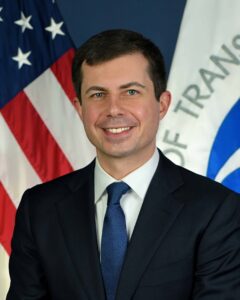
“The Biden-Harris Administration is thrilled to launch this program to fix thousands of bridges across the country —the single largest dedicated bridge investment since the construction of the Interstate highway system,” said U.S. Transportation Sec. Pete Buttigieg. “Modernizing America’s bridges will help improve safety, support economic growth, and make people’s lives better in every part of the country–across rural, suburban, urban, and tribal communities.”
Nationwide, the Bridge Formula Program is expected to help repair approximately 15,000 highway bridges. In addition to providing funds to states to replace, rehabilitate, preserve, protect, and construct highway bridges, the Bridge Formula Program has dedicated funding for Tribal transportation facility bridges as well as “off-system” bridges, which are generally locally- owned facilities not on the federal-aid highway system.
The Bipartisan Infrastructure Law includes an incentive for states to direct the new Bridge Formula Program funds to off-system bridges owned by a county, city, town or other local agency. While states generally must match federal funding with up to 20% state or local funding, the guidance issued today notes that federal funds can be used for 100% of the cost of repairing or rehabilitating such locally owned off-system bridges.
U.S. Rep. Sean Patrick Maloney reported that New York State will receive $1.9 billion from the Bipartisan Infrastructure Investment and Jobs Act to fix and rebuild its bridges. As a Member of the Transportation & Infrastructure Committee, Rep. Maloney helped draft the transformative infrastructure package and has been a critical advocate for investing in America’s bridges.
The USDOT reported that New York State, in Fiscal Year 2022, will receive $321,652,184 in main bridge funding; $56,762,150 in off-system bridges funding for a total award of $378,414,334.
“Thanks to the Infrastructure Investment and Jobs Act, we are going to fix New York’s bridges. Repairing our infrastructure has always been one of my top priorities, and I am so proud to have helped write the law that is delivering for our country,” said Rep. Maloney. “With this funding from the Federal Highway Administration, New York will receive nearly $2-billion to get to work fixing its more than 1,700 bridges in poor condition, and will create millions of good-paying jobs in the process.”
The federal bridge funding is available to improve the condition of 1,702 bridges in poor condition in New York State. In the counties that comprise New York’s 18th Congressional District, there are more than 175 bridges in poor condition. These include 42 in Dutchess, 67 in Orange, 12 in Putnam and 66 in Westchester.
New York City Update
NY, MTA Releases Feasibility Study On Interborough Express Project
NEW YORK—Gov. Kathy Hochul and MTA Acting Chair and CEO Janno Lieber on Jan. 20 unveiled the results of a yearlong study assessing feasibility of the Interborough Express, the transformative transit project which would connect communities in Brooklyn and Queens to as many as 17 subway lines and the Long Island Rail Road, and significantly reduce travel times within and between the two boroughs.
“Infrastructure is all about connection, and with the Interborough Express we can connect people to their family and friends while also improving their quality of life,” Gov. Hochul said. “The Interborough Express will connect Brooklyn and Queens, not only shaving time off commutes but also making it easier to connect to subway lines across the route. With the completion of the feasibility study, we can move forward to the next phase of this project and bring us one step closer to making the Interborough Express a reality for New Yorkers.”
The feasibility study’s results indicate that it is indeed physically feasible to accommodate passenger traffic alongside the existing freight rail traffic, that there is significant demand, and that Bus Rapid Transit, Light Rail, and conventional Heavy Rail are all options in terms of the possible modes of transit.
As announced in Gov. Hochul’s 2022 State of the State, the MTA’s next step is to conduct required state and federal environmental review processes, which will also include public engagement to gather input from communities, elected officials, and other key stakeholders to further the process of determining the most appropriate mode of transit.
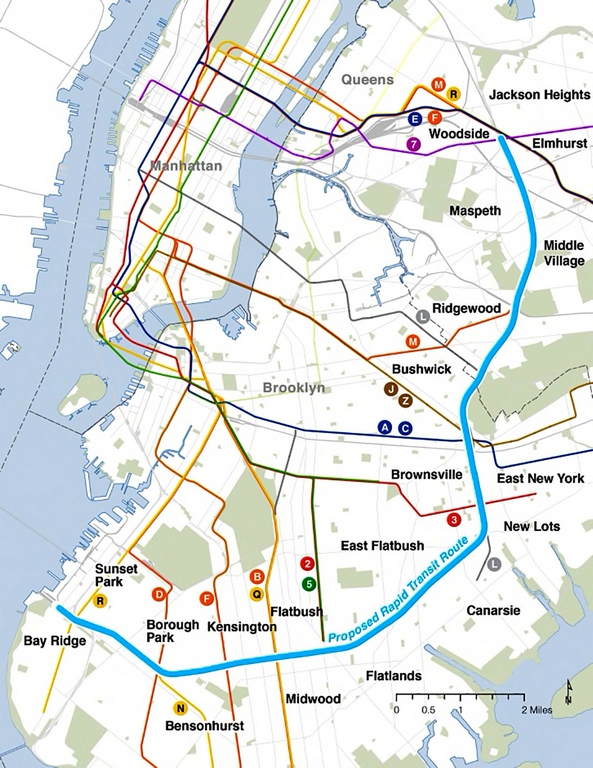
The Interborough Express would use the existing right-of-way of the Bay Ridge Branch, which is a freight rail line that runs through Brooklyn and Queens, connecting ethnically and socioeconomically diverse neighborhoods such as Bay Ridge, Sunset Park, Borough Park, Kensington, Midwood, Flatbush, Flatlands, New Lots, Brownsville, East New York, Bushwick, Ridgewood, Middle Village, Maspeth, Elmhurst and Jackson Heights. The project would include several new connections in neighborhoods that currently lack efficient connections to each other, and in some cases to Manhattan.
According to the study, up to seven out of 10 people served will be from communities of color, approximately one-half will come from households with no cars, and approximately one-third will be living in households at or below 150% of the Federal Poverty Line.
MTA Chair and CEO Lieber said, “MTA riders deserve a reliable and wide-reaching transit system that promotes equity, and this study proves The Interborough Express will provide better access to jobs, education and economic opportunities for some 80,000 New Yorkers in Queens and Brooklyn.”
The project could provide potential connections to up to 17 subway lines, (2,3,5,7,A,B,C,D,E,F,J,L,M,N,Q,R,Z) serving areas of Brooklyn and Queens while initial studies indicate up to 80,000 daily weekday riders with annual ridership of approximately 2.5 million. Travel times between Brooklyn and Queens could be reduced by up to 30 minutes each way, depending on travel distance.
Proposed service would operate at up to five-minute headways during the peak periods, with off-peak headways of up to 10 minutes at other times of the day. The number and location of stations along the 14-mile corridor will be determined as part of the forthcoming environmental, planning, and engineering studies. Additionally, transportation planners believe the new service would work in concert with the Cross-Harbor Rail Freight Tunnel project. The Port Authority will complete the environmental review for the freight tunnel as mentioned in the governor’s State of the State address. Increasing rail service and reducing truck traffic could have a significant impact on the region.
New York City Mayor Eric Adams said, “The Interborough Express is a creative proposal and a critical step towards our shared goal of providing greater connectivity for New Yorkers living in transit deserts as well as much-needed economic development. By building efficiently on existing infrastructure, we can provide commuting options for hundreds of thousands of potential riders from Middle Village and Midwood and from Brownsville and Bushwick.”
President of the New York State Building and Construction Trades Council and President of the Building and Construction Trades Council of Greater New York Gary LaBarbera said, “This is an important first step towards embarking on a thoughtful and effective infrastructure plan that will not only enhance connections between communities, but create thousands of middle-class careers with benefits in the process. The Interborough Express will be a key element of New York’s transportation infrastructure for years to come.”
Determining fares will be the responsibility of the MTA Board at time of implementation; they are expected to be equivalent to standard subway fares.
The Interborough Express could take many different forms depending on factors such as operating mode, service frequency, station locations and its relationship with existing freight tracks. The total project cost will be determined as part of the forthcoming environmental review and design process.
Financial Management
What Industry Leaders are Saying About The State of Construction in 2022

The construction industry has seen a range of challenges and shifts over the past two years—from financial uncertainty and tax code changes to new approaches to technology and workforce management. Looking ahead to 2022 and beyond, there is a lot of reason for optimism: the infrastructure bill is moving forward, and both public and private enthusiasm for new projects is rising.
However, it is still a very different landscape from the one we saw in February 2020. With more diversified project sectors today, along with the wide-scale adoption of construction technology and current labor conditions, many firms are strategizing differently for success.
Anchin recently conducted an end-of-year survey, asking leading firms to discuss the challenges and opportunities that are top of mind for executives. The survey reveals key insights into the state of the market and what still needs to change to ensure the industry can continue to deliver meaningful projects for the future.
The passing of the infrastructure bill was one of the main focuses of the survey, and a majority of respondents said their firms had diversified into infrastructure since the beginning of the pandemic. More specifically, 85% said that they believe infrastructure will be the busiest industry over the next five years. Increased growth could also be expected in the transportation, life sciences and healthcare sectors, per the survey, especially if New York City seeks to continue to expand its STEM profile through new lab spaces and other strategies. A final sector that respondents singled out was industrial, which has become an in-demand asset sector, largely due to e-commerce.
The increasing confidence in the market has led to new strategies for talent retention and acquisition. The vast majority of respondents said they had adopted a form of WFH or hybrid-work, but 47% reported they’ve raised salaries and 30% said they’ve incorporated new culture-building activities, in efforts to compete for talent and demonstrate themselves as industry leaders moving forward.
Besides the aforementioned challenges, 65% of respondents said that the biggest problems facing the industry were labor shortages and public funding for infrastructure. While labor shortages may be helped by adoption of new technologies to help attract new talent, other issues highlighted were sustainability and DEI (Diversity, Equity and Inclusion) initiatives, as well as public health and COVID-measures.
Amongst these challenges are needs that respondents identified, many of which may be aided by the $1.2 trillion federal infrastructure act. Of respondents, 75% said that flood mitigation, tunnels and rail were the most important construction needs for the city today. Roads and affordable housing were also high in mind for those in the survey. The trends here relate directly to future city resilience, specifically in the face of population growth and growing climate change problems.
With the infrastructure act’s funding comes hope for economic growth and recovery. Anchin’s survey shows this recovery had begun even before the passing of the bill, with 50% of firms reporting increased work volume, and 42% reporting decreased backlogs. Though these are encouraging signs, other problems still persist, specifically around modernization and technology. Respondents identified a need for adoption of new tech (58%) and a more skilled and diverse workforce (53%) as the most pressing issues facing the industry.
Lastly, with new work and the economy recovering, firms did report cash flow problems. The majority of firms (61%) said clients had been slower to pay, 56% said that increasing labor and material costs were slowing their cash flow, and 50% each cited rising insurance costs and project delays. While market disruption and fluctuations may be calming due to recent economic gains and stabilization, the increased costs could continue, Anchin reported based on its findings.
The diverse asset sectors in the construction, architecture and engineering sectors have contributed to growing optimism. Additionally, as shown by the survey, there are still numerous issues and market shifts facing the industry. Nevertheless, industry leaders are adapting to new hybrid roles, technology and talent retention challenges as the New York City market moves into a new era and a new year.
About the author: Phillip Ross, CPA, CGMA is an Accounting and Audit Partner and Chair of the Construction Industry Group at Anchin, Block & Anchin, LLP. For more construction industry thought leadership and content, log on to www.anchin.com.
State Awards More Than $216M In ‘BridgeNY’ Funding This Year
Region Nabs $34M for 8 Span, 8 Culvert Projects
ALBANY—New York Gov. Kathy Hochul announced recently the award of $216.2 million in enhanced assistance for 88 local governments to rehabilitate and replace bridges and culverts in every region of the state. The funding provided through the state’s “BRIDGENY” initiative supports projects that enhance safety, reduce the risk of flooding, improve resiliency of structures, facilitate regional economic competitiveness and prioritize projects that benefit environmental justice communities.
Of these municipally owned pieces of infrastructure, Gov. Hochul said, “We must continue to make these strategic investments in our local communities to protect our residents from the increased frequency of extreme weather events, as well as to provide New Yorkers with the modernized and streamlined infrastructure they deserve.”
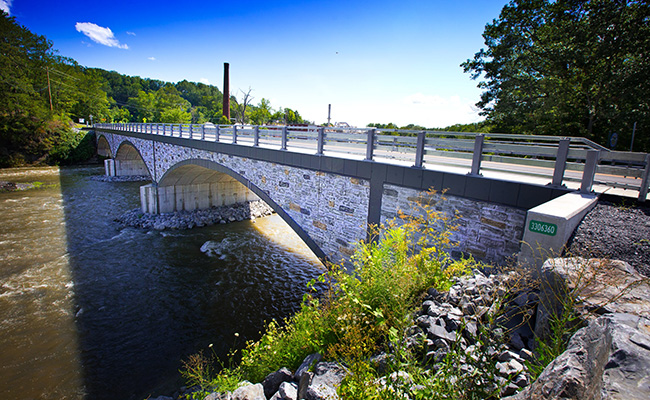
The announcement builds upon the nearly $500 million previously awarded to local governments under this initiative. The BRIDGENY awards were made through a competitive solicitation process and will support all phases of project delivery, including design, right-of-way acquisition and construction. Projects were selected based on criteria that included:
- the structural condition and susceptibility of the bridge or culvert to flooding or scour;
- the significance of the bridge or culvert based on detour considerations and the number and types of businesses served;
- benefits of the corridor on Environmental Justice Communities;
- the overall impact on the movement of commerce.
The BRIDGENY program is administered by the New York State Department of Transportation and part of the state’s sustained efforts to enhance investments in local roads, bridges and other vital transportation infrastructure across New York State.
The Mid-Hudson region secured eight bridge awards valued at $27,233,689 and eight culvert awards valued at $7,517,991 for a combined funding award of $34,751,680. New York City secured one bridge project award valued at $29.4 million.
The specific 2021 BridgeNY award recipients in the Mid-Hudson Valley, New York City region were:
Mid-Hudson Region
$34.8 million
- $1.603 million to the Town of Red Hook (Dutchess County) for the replacement of the Saw Kill Road bridge over the Saw Kill;
- $4.235 million to Orange County Department of Public Works (Orange County) for the replacement of the Hulsetown Road bridge over Cromline Creek;
- $1.256 million to Rockland County for the rehabilitation of the Lawrence Street bridge over the tributary to Pascack Brook;
- $4.477 million to Sullivan County for the replacement of the County Route 49 bridge over Neversink River;
- $4.727 million to Sullivan County for the replacement of the Beaver Brook Road bridge over Beaver Brook;
- $4.095 million to Ulster County for the replacement of the County Road 54 bridge over the Beaver Kill;
- $1.999 million to the Town of Rochester (Ulster County) for the replacement of the Boice Mill Road bridge over Falls Mill Brook;
- $4.842 million to the Town of Rye (Westchester County) for the replacement of the South Barry Avenue bridge over Otter Creek;
- $993,000 to the Town of East Fishkill (Dutchess County) for the replacement of the Hillside Lake Road culvert;
- $1.0 million to Orange County Department of Public Works for the replacement of the Neversink Drive (CR80) culvert carrying the tributary to Shinhollow Brook;
- $526,000 to the Town of Newburgh (Orange County) for the replacement of the Elmhurst Avenue culvert carrying Bushkill Creek;
- $1.0 million to Orange County Department of Public Works for the replacement of the Lakes Road (CR5) culvert carrying the tributary to Shinhollow Brook;
- $1.0 million to Putnam County for the replacement of the Peekskill Hollow Road culvert carrying Wiccopee Brook;
- $1.0 million to Putnam County for the replacement of the Snake Hill Road culvert carrying the Philipse Brook Tributary;
- $999,000 to the Town of Kent Highway Department (Putnam County) for the replacement of the Lake Louise Drive culvert;
- $999,000 to Rockland County for the replacement of the Spook Rock Road culvert carrying Willow Tree Brook.
- New York City Region
$29.4 Million - $29.4 million to the New York City Department of Transportation for the replacement of the Fifth Avenue bridge over the Brooklyn-Queens Expressway.
LOW BIDS
12 Firms Win NYSDOT Projects In NYC, Hudson Valley Regions
ALBANY—The New York State Department of Transportation recently announced the selection of 12 apparent low bidders for work in the Hudson Valley and New York City metro regions.
Transit Construction Corp. of Yonkers, NY was the lowest of three bidders at $1,856,000.00 for culvert rehabilitation and replacement. Locations are Lower Road (CR12) over tributary to Wallkill River and Wesley Chapel Road over Willow Tree Brook. 2018 BRIDGENY ROUND 2 CULVERT BUNDLE 5 in Orange and Rockland counties.
Ben Ciccone Inc. of Poughkeepsie, NY was the lowest of 20 bidders at $8,482,616.20 for ramp reconstruction I287, eastbound, to Saw Mill River Parkway northbound in Westchester County.
Constar Inc. of Central Islip, NY was the lowest of 15 bidders at $12,981,850.00 for bridges and highways – NonStructural Where and When Corrective Maintenance Repairs – in the Bronx, Kings, New York, Queens and Richmond counties.
Jorrey Excavating Inc. of Middletown, NY was the lowest of four bidders at $2,197,140.00 for build and repair sidewalks and ramps for ADA compliance in Orange County.
ELQ Industries Inc. of New Rochelle, NY was the lowest of five bidders at $10,527,576.25 for resurfacing by milling and paving routes 141 and 117, Town of Mount Pleasant in Westchester County.
Westmoreland Construction Inc. of Bronx, NY was the lowest of six bidders at $2,749,040.00 for sign panel replacement project at various locations in the Bronx and Queens.
Rover Contracting Inc. of Hopewell Junction, NY was the lowest of seven bidders at $8,115,056.00 for bridge painting at various locations in Broome, Delaware and Sullivan counties.
Rover Contracting Inc. of Hopewell Junction, NY was the lowest of six bidders at $3,921,763.00 for bridge painting at various locations in Chenango, Delaware and Sullivan counties.
Yonkers Contracting Co. Inc. of Yonkers, NY was the lowest of four bidders at $8,011,533.00 for paving on the Taconic State Parkway, from Tyrrel Road to Willow Lane in the towns of Pleasant Valley and Clinton in Dutchess County.
PCI Industries Corp. of Mount Vernon, NY was the lowest of three bidders at $1,402,500.00 for Highway Job Order Contract at various locations in Putnam, Rockland and Westchester counties.
Dom’s Lawnmaker Inc. (DBA Dom’s Tree Inc.) of Port Washington, NY was the sole bidder at $2,950,395.76 for landscape improvements at various locations in Dutchess, Orange, Rockland, Ulster and Westchester counties.
Economy Paving Co. Inc. of Cortland, NY was the lowest of five bidders at $1,277,227.27 for scour repair at Route 17 over Debruce and Willowemoc in the Town of Rockland in Sullivan County.
Statement from Construction Industry Council Executive Director John Cooney, Jr., in Response to Gov. Kathy Hochul State of the State
TARRYTOWN, NY – “New York Gov. Kathy Hochul demonstrated a keen understanding of the needs in our state today, which she outlined in her 2022 State-of-the-State presentation today,” said John Cooney, Jr., Executive Director of the Construction Industry Council of Westchester & Hudson Valley, Inc. “We applaud her fervent commitment to accelerate infrastructure improvements and to expand transportation mobility to make the state more business friendly and to make the Empire State the nexus of commerce as a place where opportunities are made available to more New Yorkers.”
Among the projects identified in the plan she noted on Jan. 5 include the accelerate conversion of Route 17 into I-86 in Orange
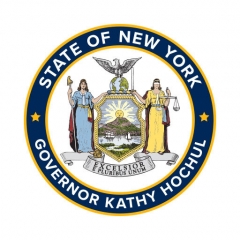
and Sullivan counties. She also pointed to other strategic investments New York State has made in the Mid-Hudson Valley which have resulted in the expansion of Woodbury Common and the construction of Legoland and the Resorts World Catskills Casino.
“Over the past several years, projects have been completed by NYSDOT to upgrade sections of Route 17, including reconstruction of the interchange at Exit 131, where Route 17 meets Interstate 87 and Route 32 (Woodbury Common), and reconstruction of Exits 122 and 125 (Legoland) to meet interstate standards. To facilitate future economic competitiveness and alleviate congestion within the region, the State will begin an environmental review to assess the conversion of the full Route 17 corridor in Orange and Sullivan counties to Interstate 86,” the report said.
“For generations, New York has stood as a beacon of hope and prosperity for the nation and people throughout the world. Her plan promises to reinforce and amplify that role,” Mr. Cooney added. “We applaud Gov. Hochul for her panoramic vision and confidence to lead our state past today’s pandemic challenges and to ensure the continued economic growth and infrastructure resiliency.”
Mr. Cooney concluded, “The CIC looks forward to learning more about her plans over the coming months and stand ready to support her in her commitment to infrastructure as a powerful public resource to connect people to jobs and to connect all New Yorkers for a more prosperous and promising future.”






Louis G. Nappi Construction Labor-Management Scholarship Fund Awards $85,000 to 17 College Students in Hudson Valley Region
By GEORGE DRAPEAU III
TARRYTOWN – Seventeen Hudson Valley college students began the 2021-22 academic year with a $5,000 grant from the Louis G. Nappi Construction Labor-Management Scholarship Fund for undergraduate studies in mathematics, the sciences, engineering and technology.
The scholarship, a major construction industry financial-aid program, was established in 2009 by Louis G. Nappi (1920-2014), a former Chairman (now Emeritus) of the Construction Industry Council of Westchester & Hudson Valley, Inc. It was his vision that the hard sciences of mathematics and engineering were keys to re-establishing the U.S. as a world leader in transportation and infrastructure construction.
Comprising representatives from both labor and management, the Louis G. Nappi Scholarship Committee carefully selects candidates who exemplify the high scholastic and personal standards needed to advance in the construction and building industries.
“This scholarship is a living testimony to Louis Nappi,” said Ross J. Pepe, President of the Construction Industry Council, of which Nappi was chairman from 1986 to 1991. “Lou’s commitment to engineering and science lives on today in these scholarships and through these students.”
Mr. Pepe added, “Lou believed that giving students the financial means to pursue higher education and advanced degrees would help our nation’s construction and building industries regain global competitiveness and preeminence.”
Scholarship Committee Chairman William Mascetta, President of Transit Construction Corp. of Yonkers, N.Y., congratulated the winners and reminded them of the value of learning practical skills and avoiding “digital distraction.”
“In this high-tech age, with unlimited access to information, it’s tempting to rely on technology very heavily,” Mr. Mascetta said. “However, remember that we build things and our world of infrastructure is three-dimensional. When you get caught up in digital distraction, it’s like going through life with blinders on. You, as future scientists and executives, must take off the blinders and open yourselves to the full periphery and reality of what we do.”
Mr. Mascetta thanked the members of the Scholarship Committee representing labor and management, and applauded the students’ parents for their support. He acknowledged Lou Nappi’s family for its ongoing commitment, and cited appreciation to Moujalli Hourani, D.Sc., a professor of Engineering at Manhattan College in Riverdale, N.Y., for his guidance of the students and the scholarship program.
Marking its 12th anniversary, the Louis G. Nappi Scholarship Fund has awarded more than $785,000 in 187 grants to some 78 students attending nearly 50 colleges and universities throughout the U.S. Candidates mostly reside in the seven-county region of the lower Hudson Valley—Westchester, Putnam, Dutchess, Columbia, Ulster, Orange and Rockland—and are related to employees of CIC-member companies or affiliated unions. The participating labor unions are Laborers International Union of N.A. Local 60, International Union of Operating Engineers Local 137, and the International Brotherhood of Teamsters Local 456.
Scholarship Winners
Julia Maria Apostolou, 19, of Yorktown Heights, NY, is a sophomore studying civil engineering at the University of South Carolina. She is the daughter of James Apostolou who is a member of Teamsters & Chauffeurs L.U. 456 of Elmsford, NY. Julia Maria is also a recipient of a 2020 Louis G. Nappi Scholarship grant.
Samantha Argenio, 21, of Carolina Beach, NC, is a senior studying business administration with a concentration in finance at North Carolina State University in Raleigh. She is the granddaughter of a principal at Argenio Bros., a member company of the Contractors Association of Rockland County. Samantha is also a recipient of a 2020 Louis G. Nappi Scholarship grant.
Sebastian Arreola, 20, of Danbury, CT, is a junior studying computer engineering at the University of Hartford in West Hartford, CT. He is the grandson of Mario Anaya of Heavy Construction Laborers L.U. 60. Sebastian is also the recipient of three Louis G. Nappi Scholarship grants from 2018 to 2020.
Taylor Bruck, 19, of New Paltz, NY, is a sophomore studying computer science at Binghamton University in Binghamton, N.Y. She is the daughter of Thomas Bruck, a member of Operating Engineers L.U. 137. Taylor is also a recipient of a 2020 Louis G. Nappi Scholarship grant.
Robert Caulfield, 19, of Blauvelt, NY, is a sophomore studying civil engineering at Manhattan College in Riverdale, NY. He is the son of Timothy Caulfield of Yonkers Contracting Co., Inc., a CIC-member company. Robert is also a recipient of a 2020 Louis G. Nappi Scholarship grant.
Ryan Danyluk, 21, of New Windsor, N.Y., is a senior studying civil engineering at Wentworth Institute of Technology in Boston, MA. He is the son of Peter Danyluk of Walsh Construction/Grace Industries, a CIC-member company. Ryan has now been a recipient of four Louis G. Nappi Scholarship grant awards (2018-2021). Nice going, Ryan!
Massimo Fante, 19, of Sleepy Hollow, NY, is a sophomore studying biological sciences at Cornell University in Ithaca, NY. He is the son of Mark Fante of Darante Construction Ltd., a CIC-member company. Massimo is also a recipient of a 2020 Louis G. Nappi Scholarship grant.
Jamie Lynn Fortunato, 20, of Fairfield, CT, is a junior studying biology and pre-health at the University of Wisconsin at Madison. She is the granddaughter of Anthony Guido, a member of Operating Engineers L.U. 137. Jamie Lynn is also a recipient of a 2020 Louis G. Nappi Scholarship grant.
Daisy Godoy, 22, of Lagrangeville, NY, is a senior majoring in architectural technology at New York Institute of Technology. She is the daughter of Jesus Godoy, a member of Heavy Construction Laborers L.U. 60. Daisy is also a recipient of a 2020 Louis G. Nappi Scholarship grant.
Mark Griffin, 19, of Yonkers, NY, is a sophomore majoring in aerospace and mechanical engineering at the University of Buffalo. He is the son of Lisa Griffin and nephew of Vincent Romagnoli of Yonkers Contracting Company, Inc., a CIC-member company.
Alyssa Mangone, 21, of Hartsdale, NY, is a senior studying business management at Quinnipiac University in Hamden, CT. She is the granddaughter of George Meinel and niece of James Meinel who are members of Operating Engineers L.U. 137 of Briarcliff, NY. Alyssa now has been the recipient of four Louis G. Nappi Scholarship grants (2018-2021).
Sophia Mangone, 18, of Hartsdale, NY, is a freshman at SUNY Oneonta. She is the granddaughter of George Meinel and niece to James Meinel who are members of Operating Engineers L.U. 137 of Briarcliff, NY.
Cooper Mistishin, 19, of Lake Areal, PA, is a sophomore studying software engineering at Rochester Institute of Technology. He is the son of Michael Mistishin, an employee of Peckham Industries, a CIC-member company.
Daniella Mulvey, 21, of Valhalla, NY, is a senior studying architecture at Ithaca College in Ithaca, N.Y. She is the daughter of Dennis Mulvey, an employee of Stratis Contracting Corp., a CIC-member company. Daniella is also the recipient of a Louis G. Nappi Scholarship grant in 2020.
Nicholas Mulvey, 18, of Valhalla, NY, is a freshman studying civil engineering at Bucknell University in Bucknell, PA. He is the son of Dennis Mulvey, an employee of Stratis Contracting Corp., a CIC-member company.
William Roberts, 18, of Montrose, NY, is a freshman studying computer engineering at George Washington University. He is the son of a member of Teamsters & Chauffeurs L.U. 456 of Elmsford, NY.
Ava Zorilo, 19, of Wappingers Falls, NY, is a sophomore studying Health Science at Pace University in Westchester. Ava is the daughter of a member of Operating Engineers L.U. 137 of Briarcliff, NY.
For information on the program, contact Karen Zedda at (914) 631-6070 or Karen@cicnys.org.











